This is part of my ongoing series in which I compare four translations of Final Fantasy VI with the original Japanese script. For project details and my translation notes from Day 1, see here.
Part 13: World of Ruin #2
This time we checked out everything else there was to do in the World of Ruin. Halfway through I accidentally got everyone to Level 99, but that helped speed us through some annoying parts anyway.
After this update, only Kefka’s Tower and the ending remain. The end comes… beyond chaos.
Video Archive
This article covers content from three separate streams. You can see the archived videos here:
- Finding Shadow in the Veldt cave → finding Umaro
- Finding Relm → finishing Cyan’s dream
- World of Ruin wrap-up
Notes
My notes below cover only a small portion of the translation topics discussed during these streams. So if you want to see even more changes, details, mistranslations, etc., check out the videos above.
Frightful Dragon
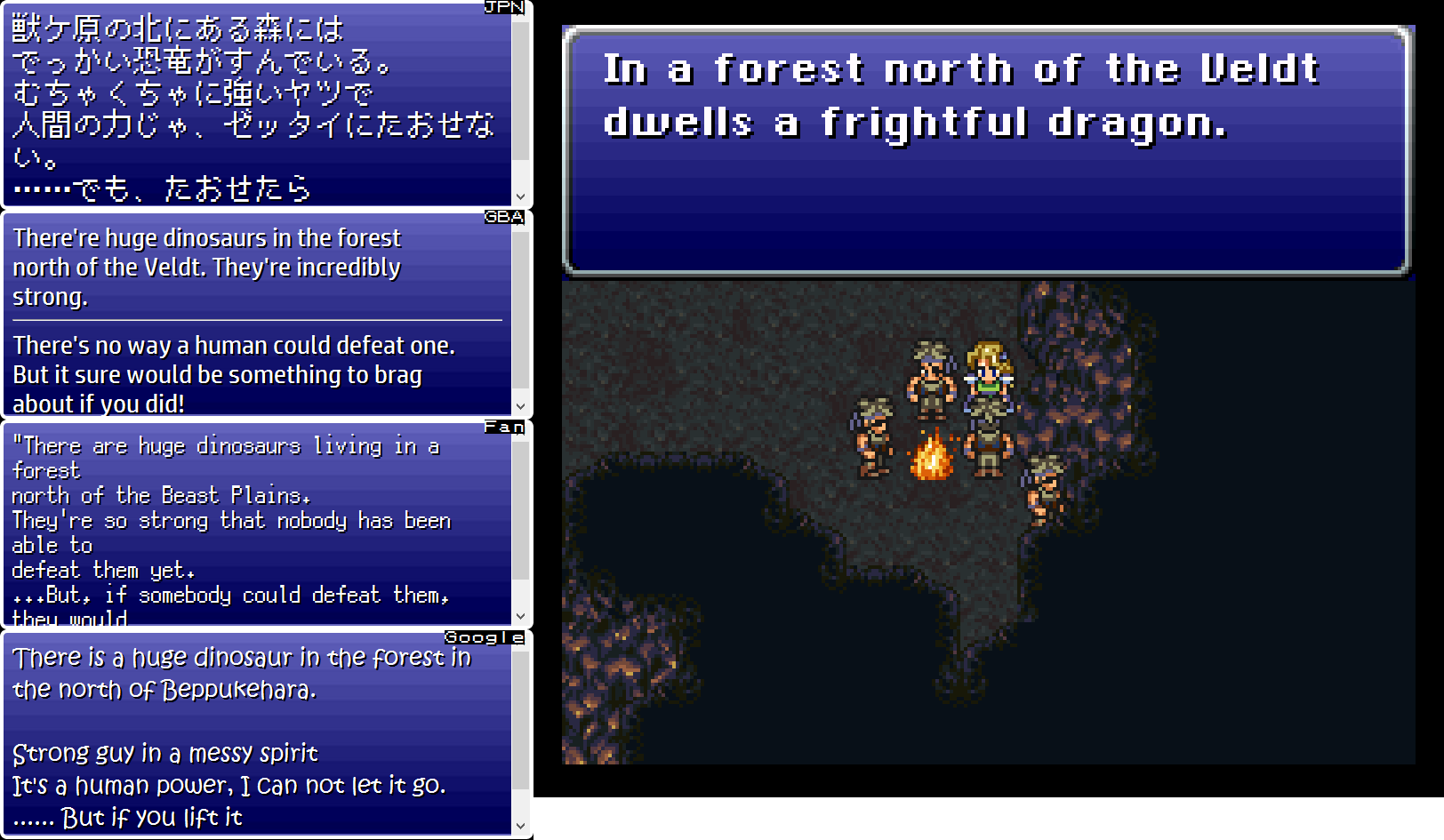
In the Super NES translation, a character in the Veldt cave says:
In a forest north of the Veldt dwells a frightful dragon.
I never thought about this too much, but I’ve heard that some fans took this to mean that there was a secret ninth dragon to be defeated. I imagine it led to a lot of wasted time and pointless searches, though. This is because the Japanese line says something different:
Huge dinosaurs live in a forest north of the Beast Plains.
And sure enough, there are some big, strong dinosaur enemies in a certain forest north of the Veldt:
How did the Super NES translation get this wrong? It’s pretty simple: the Japanese word for dinosaur is 恐竜 (kyōryū), and 恐 means “terrifying” and 竜 means “dragon”. The Super NES translator wasn’t aware that 恐竜 is an ordinary Japanese word and instead mistook it for a fictional term. So he translated the word by looking at the individual characters, resulting in “frightful dragon”.
The fact that there are eight dragons hidden throughout the world was an unfortunate coincidence. After looking at all these old game translations, I’ve started to notice that this happened with some frequency – mistranslations didn’t seem like mistranslations at first due to coincidental, unintended connections to other things.
I remember fans pointing out this dragon/dinosaur mistake a lot back in the day. I also recall reading an interview with Ted Woolsey, the Super NES translator, 10 or more years ago. In it, he specifically mentioned this “frightful dragon” mistake. I can’t seem to find that interview now, but if anyone out there knows what I’m talking about, let me know.
Death Penalty
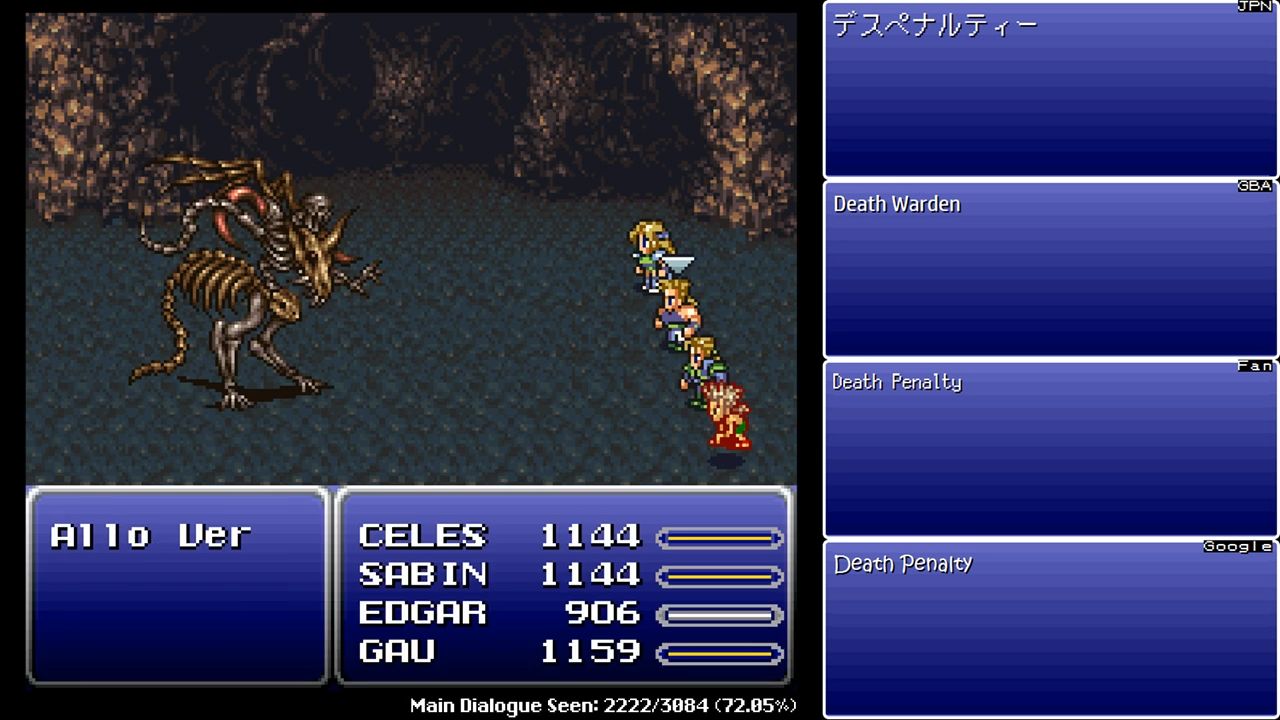
During the stream, we noticed that this enemy has a really strange name in the Super NES version: “Allo Ver”. What makes this weirder is that the enemy is called “Death Penalty” in the Japanese version. By that, I mean if you had someone pronounce the Japanese name, it’d literally sound like the English word “death penalty”. So what happened in the translation?
First, it’s obvious that the name was changed to avoid the word “death”, just as we’ve seen countless times before in the Super NES translation. Still, what’s “Allo Ver”? After a minute or two of pondering, someone in the chat mentioned that if you put the words together it becomes “Allover”… or “All Over”. Man, talk about an obtuse naming decision!
The GBA translation changes the name slightly to “Death Warden”. The fan translation and Google translation keep it in line with the original name.
The Shadow & Relm Problem
The Super NES version of Final Fantasy VI features a famous translation issue involving Relm and Shadow:
As we can see in the screenshots above, the issue is that the script suddenly starts referring to Shadow as “her” after using “he” everywhere else in the script. This happens because Relm appears here normally, but Shadow takes her place here if you save him before leaving the Floating Continent. Most translation issues in the game probably weren’t immediately noticeable to players back in the day, but this is one that was clear as day to anyone.
So what happened? In Japanese, it’s normal to drop the subjects and/or objects of sentences if it’s clear what’s being spoken about, and that’s how these particular lines work in the original script. They don’t specify who is being spoken about since it’s clear from context. This means the Japanese lines could apply to anyone or anything and not seem out of place.
It’s very likely that the Super NES translator wasn’t aware that Shadow could appear here in place of Relm, so the line was translated specifically with Relm in mind. As a result, when Shadow appears here, the line still uses the “her” pronoun.
Whenever situations like this arise, it sometimes becomes a translation challenge to keep unstated pronouns unstated. In the GBA translation’s case, we see that the first part focuses on the wounds and that the second part is changed to avoid referring to the person entirely. In the fan translation, the first part is changed to imply that some treatment has already been applied, and the second part uses the pronoun “them”.
This is one of those tricky situations that I could see being on a translation agency’s application test. It’s also a good example of why context is important when translating. If a developer had left a note for the Super NES translator, or if the Super NES translator had had more time to play through the game, this situation could’ve been easily avoided.
Flying Fish

In the Japanese script, this character says he saw a monster flying through the sky and that it looked like a giant ray.
In the Super NES translation, the guy instead says the monster looked “just like a fish”. I’m no fish expert, but this doesn’t strike me as a fish:
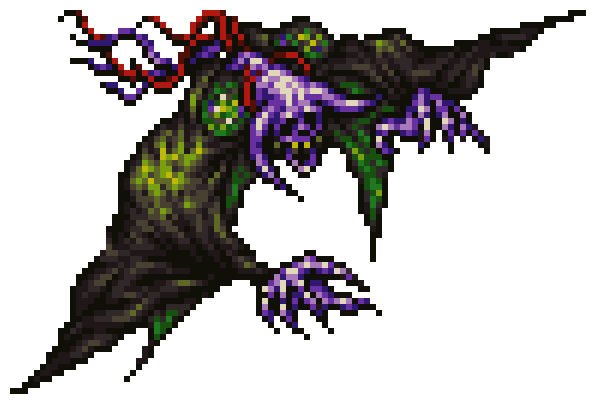
The Game Boy Advance translation also uses a different comparison and says the monster “looked like a giant bat”. This is much more believable than the Super NES translation and fits with the idea of a flying monster.
The fan translation borrows from the Super NES translation and says the monster was “shaped like a fish”. Meanwhile, the Google translation says the monster was “shaped like a gigantic rain”. Based on my own Google translation experiments, I believe Google actually had the right idea by going with “ray”, but was ultimately thwarted by its tendency to tweak words at the last minute for no reason, resulting in “rain” here.
In the end, none of the translations reflect what’s said in the original Japanese line.
Fashion Sense
In an optional side quest, the heroes take Gau to get some nice clothes before reuniting with his father. The Super NES translation is a complete mess during this scene, from start to end. I think the fact that it’s optional and that it offers few contextual clues made it especially tough for the Super NES translator to handle.
The fan translation borrows from the Super NES translation, and the GBA translation fixes everything up as best as possible.
There’s one small part involving Cyan that stood out to me, though. In Japanese, it goes something like this:
Cyan: Perhaps this hat would be perfect.
???: Talk about terrible sensu!
Cyan: Wh-what? Just how is this a sensu!?
???: ……
The joke here involves the word センス (sensu, "sense of fashion/humor/etc.") and the word 扇子 (sensu, "a folding fan"). Both words have the same pronunciation, but Cyan is dense and misunderstands.
It feels like the Super NES translator rushed through this scene at top speed. This part in particular seems to involve misunderstandings and mistranslations, resulting in a hat that suddenly disappears:
Cyan: What a jaunty hat.
???: Not at…
Cyan: Wait a minute! Where’s the hat?
???: ……
Normally I’d mark something like this as a purposeful change, but the specific way it changed leads me to believe it was a genuine mistranslation instead.
In straightforward text, doko does indeed mean “where”, but it’s not always a 1-to-1 thing. If you see “(A) no doko ga (B)” in a question – like in this case – it’s asking something closer to “in what way is (A) (B)?”. So Cyan is actually saying: “In what way is this a folding fan?” and not asking about actual locations.
Since this section of text involves two Japanese words sounding the same, the GBA translator replaced it with English text that works in a similar way. The unidentified character now uses the word “clown”, Cyan mistakes it as “crown”, and then the unidentified character gives a completely new response to round out the new joke:
Cyan: Now this is a fine and jaunty little hat!
???: Maybe if he were a clown…
Cyan: What was that? If he wore a crown?
???: Ha! We don’t want his father thinking he’s some kind of prince, now, do we?
Trying to explain foreign language wordplay across multiple translations while juggling mistranslations and misunderstandings is tough work. But hopefully some of this makes sensu.
Carrying Gau
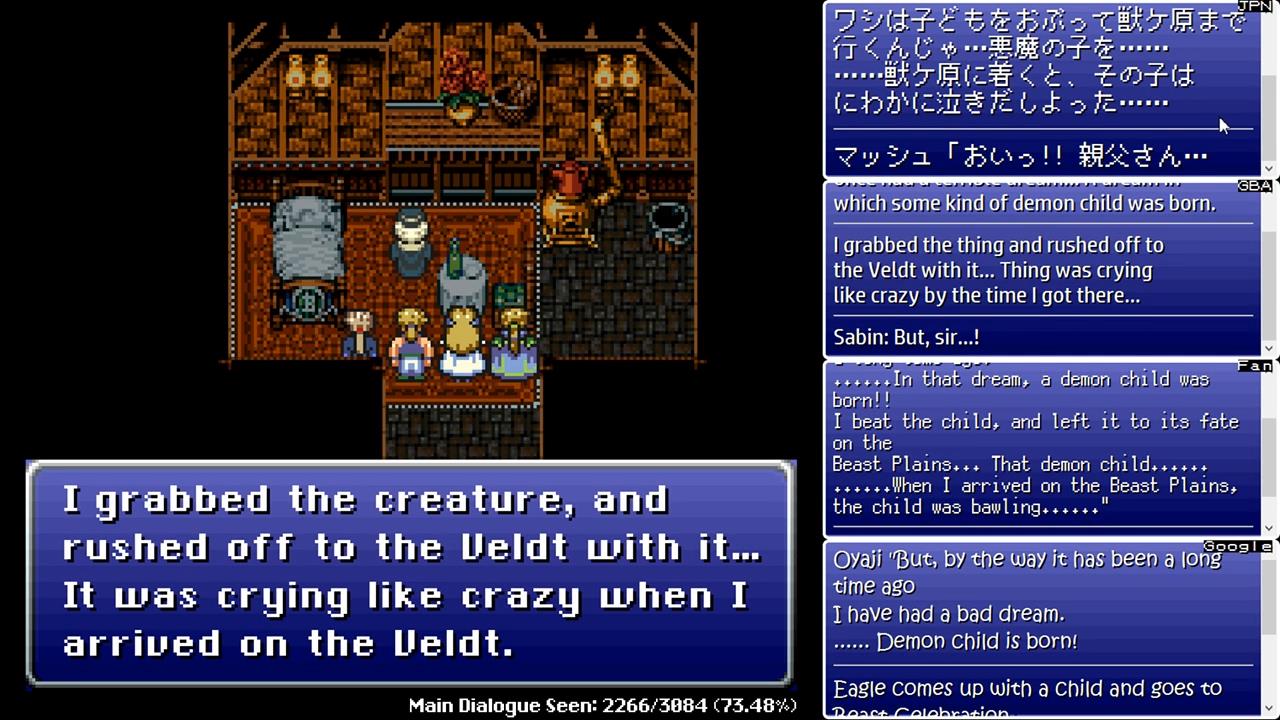
In Japanese, Gau’s father says he had a dream in which he carried a devil child away to the Beast Plains. In the fan translation, he instead says “I beat the child”.
…I’m not sure how it happened, but that’s quite the mistake to make.
Sudden Husband

The characters Duane and Katarin were in love earlier in the game. But Duane reacted poorly after Katarin recently revealed that she’s pregnant. Eventually, Duane comes to apologize to Katarin. In Japanese, he says something like:
I’m sorry, Katarin. I… didn’t know how to handle this. I’m pathetic.
The issue of teenage pregnancy – or some variation of it – was probably considered iffy territory for the Super NES release, which is why the line changed to:
Katarin… … I’m sorry. I didn’t know how to handle this. I’ve been an awful husband…
The GBA translation undoes this husband assignment, as does the fan translation. The Google translation is kind of mesmerizing in its own way.
Look Who’s Talking
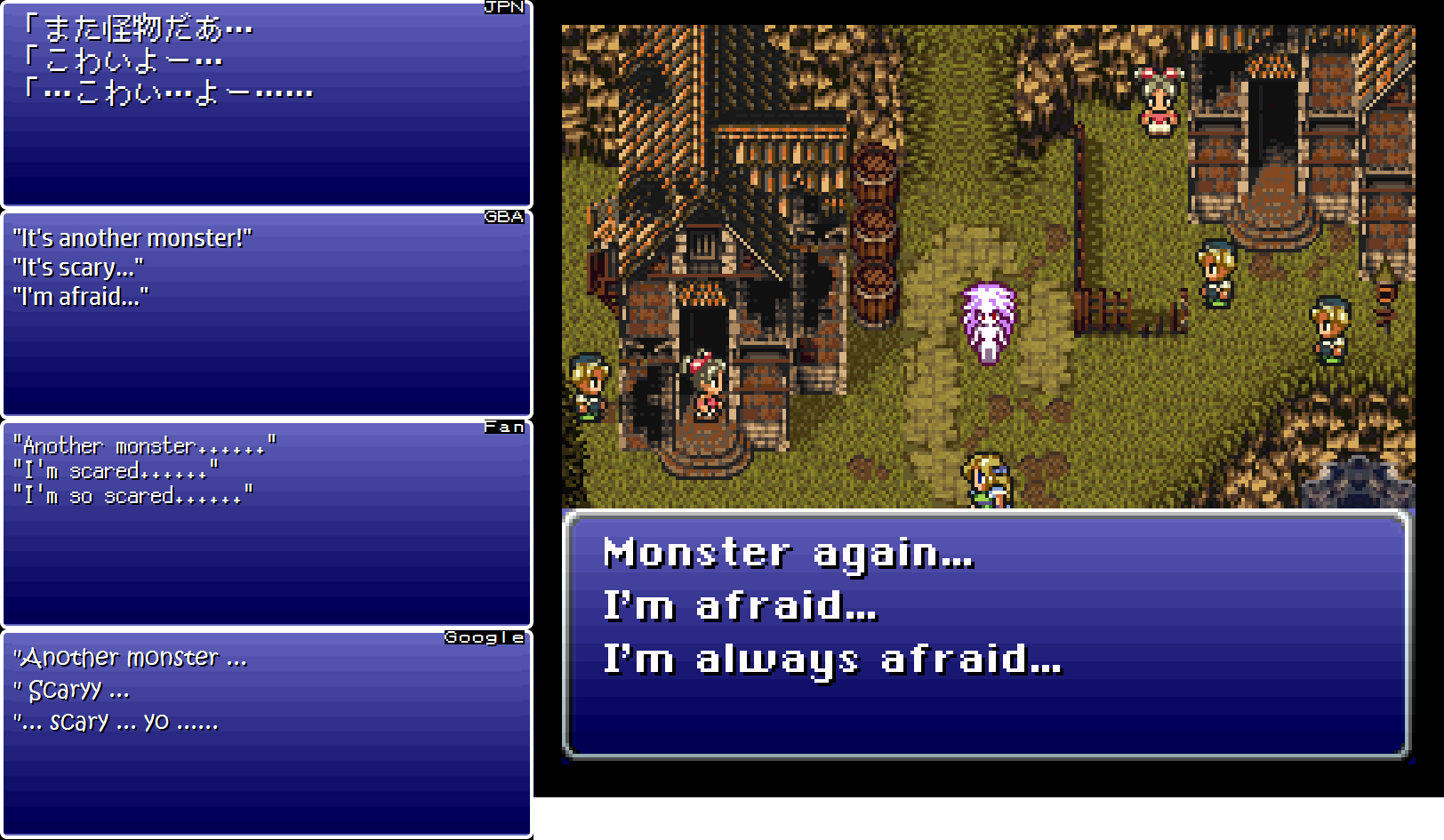
Terra transforms when a giant monster threatens the children she’s taking care of. During this scene, there’s some text in the Super NES text that’s not attributed to anyone but is written from Terra’s point of view. In Japanese, though, much of this text doesn’t belong to Terra at all. The text formatting and punctuation makes it clear that it’s supposed to be multiple children talking about Terra.
We’ve seen this happen a few times previously in the Super NES translation of Final Fantasy VI, but it’s something that we’ve also seen in the Super NES translation of Final Fantasy IV as well, and that was translated by a different person. It’s a recurring problem that I suspect secretly plagued more game translations from the era.
In this particular case, the GBA, fan, and Google translations all make it clear that there are multiple children talking, and that they’re talking about Terra and not Terra talking about herself.
Treasure Tracking
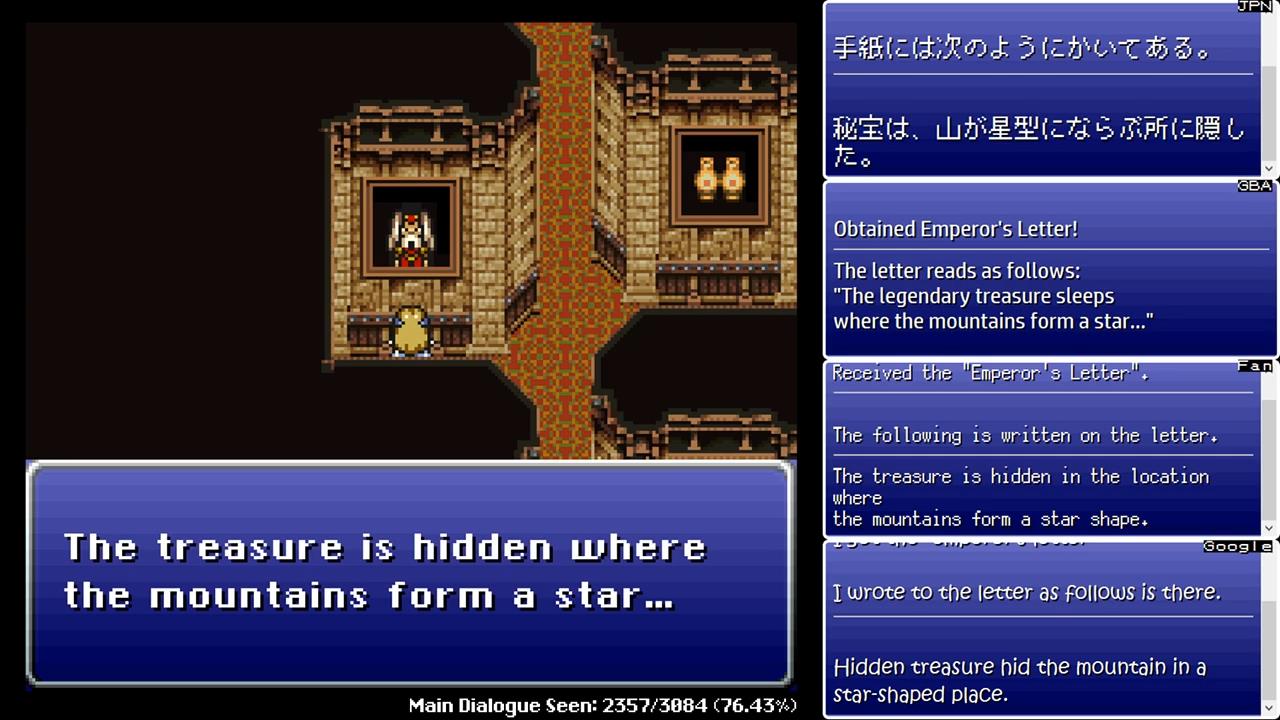
Locke has been searching for a single, specific treasure since before the beginning of the game. In Japanese, the specific word used for this treasure has been 秘宝 (hihō, "secret treasure"), and it hasn’t been used to refer to any other treasure in the game. But, as we’ve seen in previous sections, this word has been accidentally overlooked or written out of the Super NES translation nearly every time so far. Even now, near the end of the game, the Super NES translation barely acknowledges that this treasure is on a different level than other ordinary treasure.
For example, the clue to finding Locke’s secret treasure is in a letter from the emperor. In the Japanese script, the letter talks about a hihō, which is meant to make you think, “Oh! This must talking about that special treasure Locke is looking for!”. But the Super NES translation just says “treasure”, which could refer to any old treasure and doesn’t firmly connect with anything in particular.
We see that the GBA translation places the secret treasure on a higher pedestal by calling it a “legendary treasure”. The GBA translation has actually been consistent about calling it a “legendary treasure” from the start, which demonstrates a clear understanding of text details and a focus on preserving those details in a consistent way.
In the end, you still find Locke in the cave and his backstory with Rachel gets the same bittersweet resolution. But for me, it’s been interesting to watch how the Super NES translation has consistently snipped this story thread along the way.
Still Life
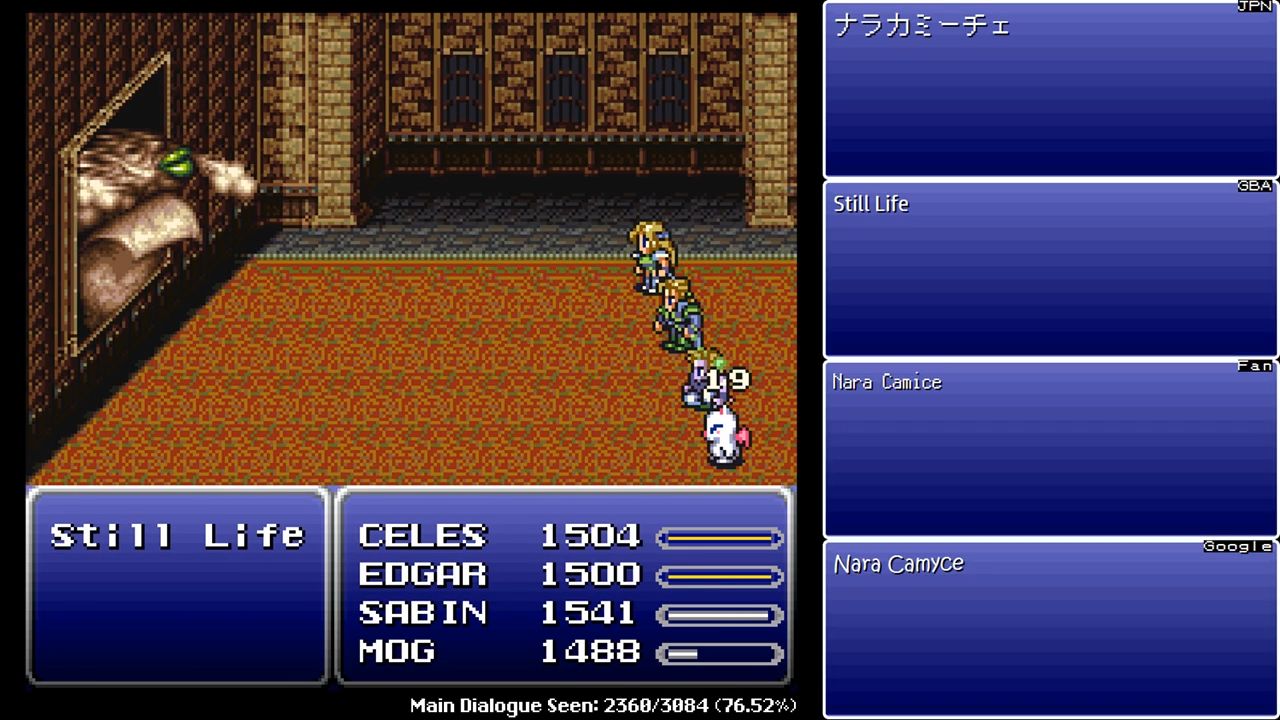
A very strange painting monster attacks the heroes. In the Japanese game, the monster is called ナラカミーチェ (narakamīche). What does this mean and/or where does it come from? It’s not really clear, but there’s a big Italian shirt company that’s spelled the exact same way in Japanese. The company is known as Nara Camicie , and it even expanded into Japan in 1985.
So is this painting monster named after a shirt company? We’d have to ask the original developers to find out for sure, I guess. If anyone has further insight into this name, let me know.
In any case, the strange name likely baffled the Super NES translator, so the monster was given a brand new name: “Still Life”. This name was carried over into the GBA translation too. Meanwhile, the fan translation and Google translation try to go with something closer to the Japanese name.
Rude Relm
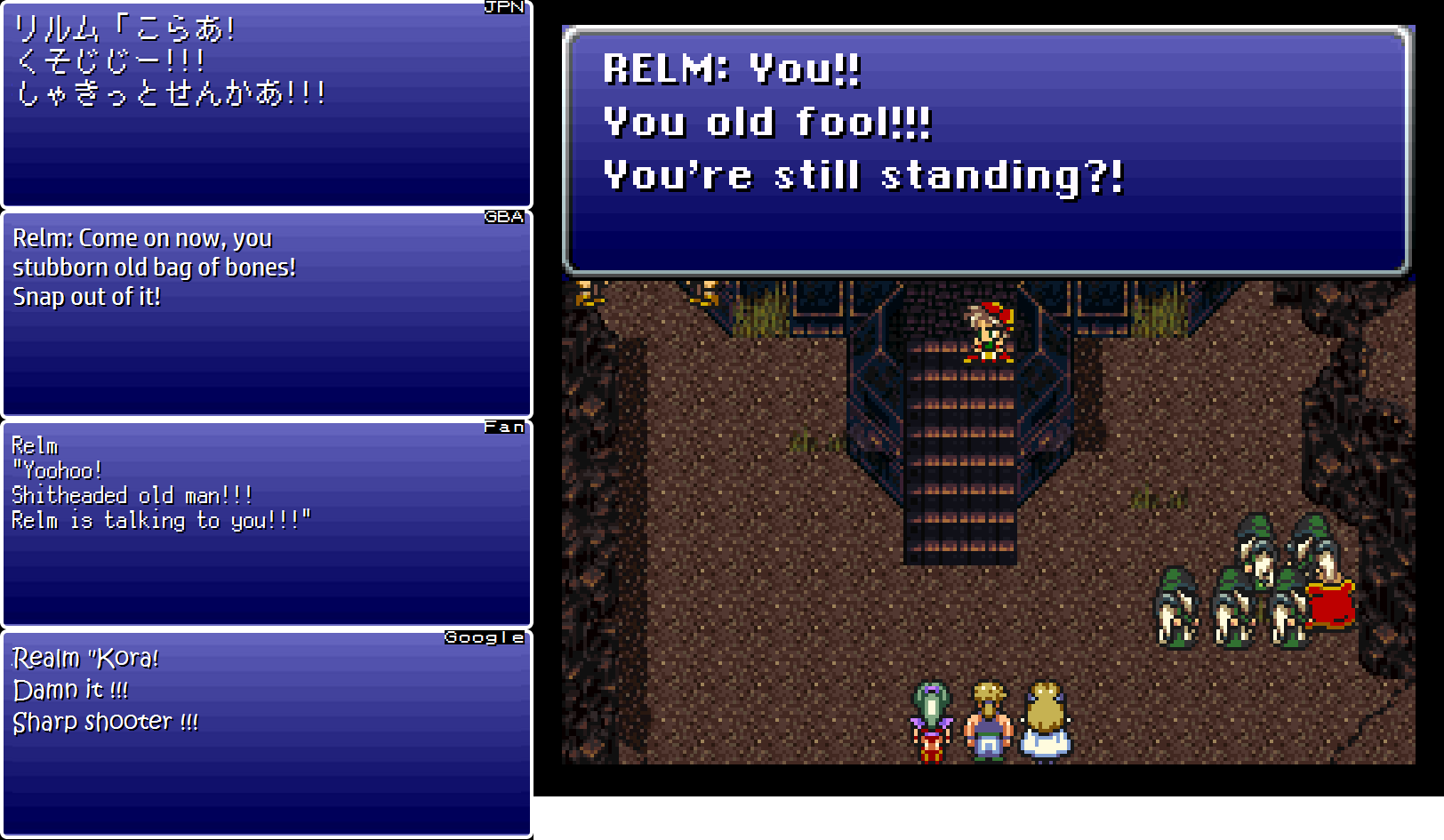
Relm discovers Strago marching around with a bunch of Kefka cultists. Upon seeing this, she yells at him in Japanese in a surprisingly rude way. Rudeness rarely converts 1-to-1 between Japanese and English, but to me the line roughly feels something like:
Hey, you! Old fart! Get your act together, dammit!
The Super NES translation couldn’t get too rude, so it’s a little lighter than the original line. But the main line is mistranslated anyway, so it doesn’t matter too much.
The fan translation takes the rudeness to a really high level that seems out of place, but it’s clear that the translator was at least trying to emulate the surprising rudeness of the Japanese line. Again, the main line is mistranslated, but not in the same way as the Super NES translation. My guess is that translator wasn’t familiar with the grammar in the third line.
The GBA translation properly translates everything and handles the line in a disciplined manner without resorting to heavy swearing.
Drink Up
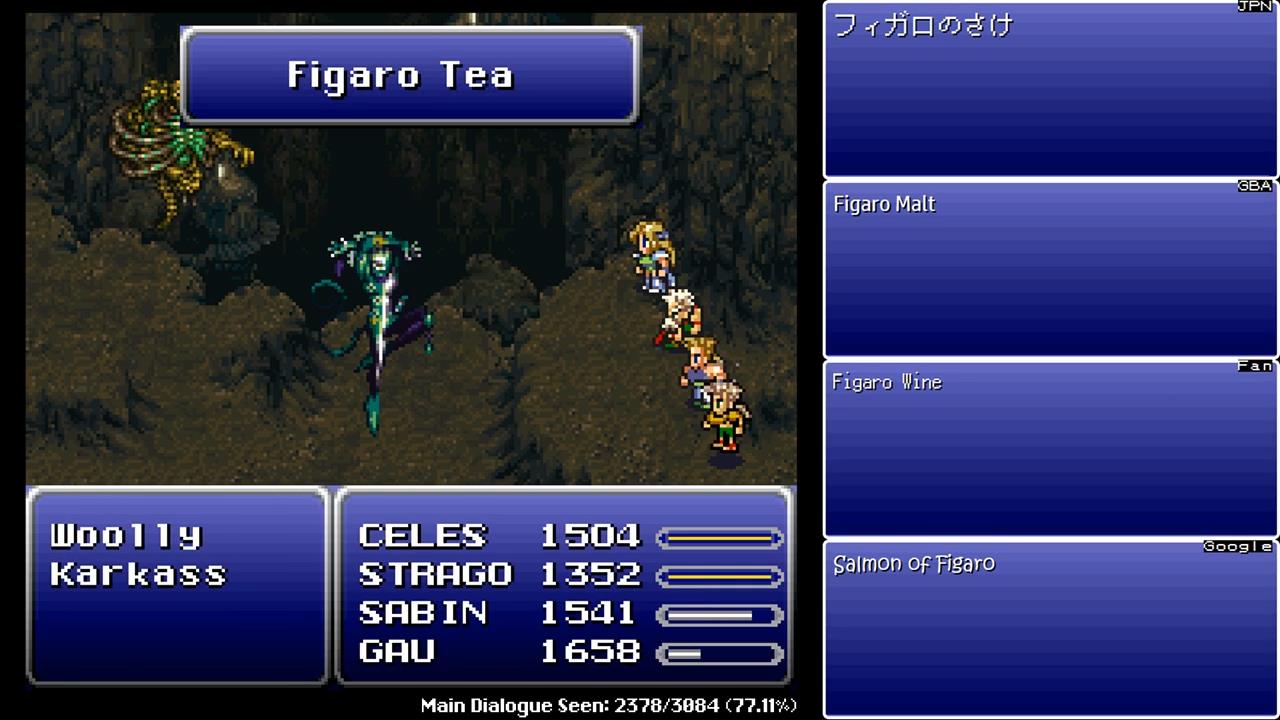
In the Japanese game, a monster inside Gogo’s cave sometimes uses an attack called フィガロのさけ (figaro no sake), which means something like “Figaro Liquor” or “Figaro Alcohol”.
Unsurprisingly, this was changed in the Super NES translation. But instead of doing the usual alcohol-to-coffee change seen during this era of gaming, the attack was renamed “Figaro Tea”. The GBA translation goes with “Figaro Malt”, and the fan translation goes with “Figaro Wine”.
Japanese is full of words that sound the same but have very different meanings. This includes the word sake, which can mean “alcohol” or “salmon”. It’s usually clear which meaning is intended depending on the context – it’s not every day you drink salmon or go fishing for liquor. But this also explains why Google gets this translation so wrong and calls the attack “Figaro Salmon”.
Gogo’s Introduction
Gogo is a secret, optional character in Final Fantasy VI who is wrapped in shrouds, mystery, and fan theories.

In Japanese, Gogo is introduced with something like:
A man clad in peculiar clothing… Or, wait, is it a man, a woman, or even human? It’s impossible to tell from looks alone.
The Super NES translation condenses the text and drops the idea that Gogo might be non-human. The GBA translation stays closer to the original text but drops the line about Gogo’s appearance. The fan translation stays close, but I can also see a minor Japanese misunderstanding in it.

Still, despite what the introduction says, Gogo uses the pronoun 俺 (ore), one of the most masculine first-person pronouns in Japanese. Normally, you’d think Gogo would use a more neutral pronoun like 私 (watashi), so this is a bit surprising. In addition to this, one of the official Japanese guides also mentions that Gogo is male:
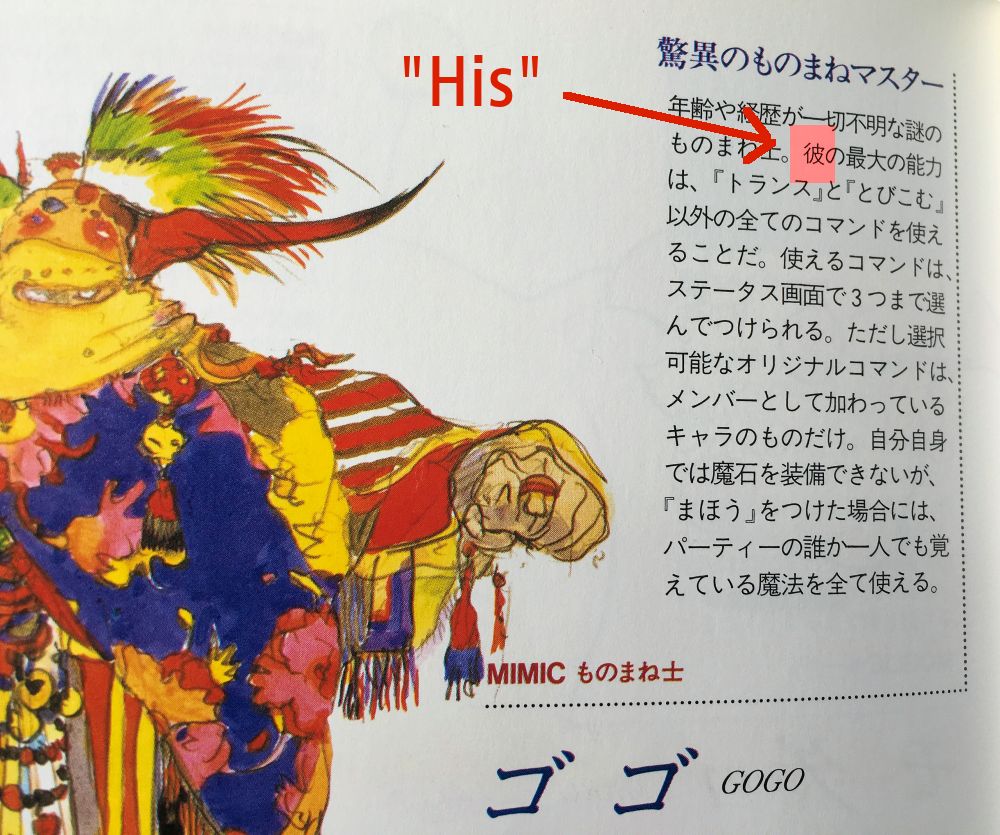
So we have at least two things suggesting Gogo is male. Still, if the game’s writers say Gogo’s identity is supposed to be a mystery, why suddenly solve the mystery like this? I’m not really sure what to think, but I’ve also heard that the Final Fantasy VI Gogo makes a secret cameo in a Hanjuku Hero game (the 4th one, I believe) and that Gogo is unquestionably specified as being male. I haven’t played the game myself and haven’t been able to fully confirm it yet.
Anyway, I know there’ve been lots of rumors and theories about Gogo over the past 20+ years, but I never paid much attention to them. I probably haven’t been able to shed any new light on the subject, but I’m still curious about what all the old rumors were. So if you recall any of Gogo’s rumors and/or why they came about, let me know in the comments!
Dream Team
Cyan’s mind is invaded by three dream demons who look like children. In Japanese, these demons call themselves the “Three Dream Brothers” and are known as Rêve, Sogno, and Sueño. These names mean “dream” in French, Italian, and Spanish.
The Super NES translation changes all of this and calls them the “3 Dream Stooges”, which is a reference to the famous Three Stooges, a trio of nitwits and knuckleheads. The Super NES translation also renames the demons Moe, Larry, and Curley, which were also taken directly from the Three Stooges:
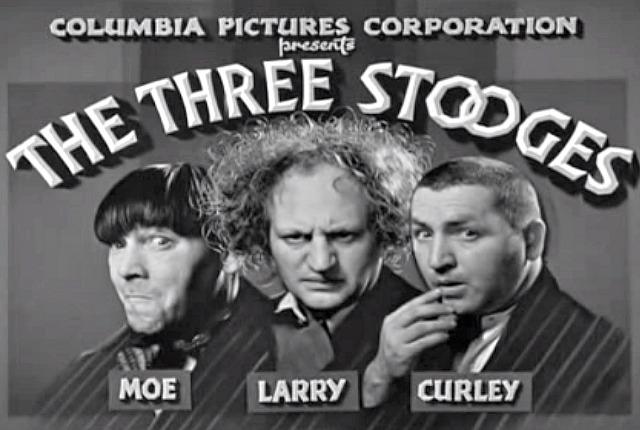
I’m a big Three Stooges fan and was happy to see two of my favorite things come together like this, but I also knew that there was no way they were called that in Japan and that the references were added in. I also remember feeling that it cheapened this part of the game and that I always dreaded it in subsequent playthroughs… but then again maybe I was just bad at this part of the game.
Now that I look back at it 20+ years later as a professional translator, it absolutely feels like a forced, unnecessary reference on par with other infamous examples:
The GBA translation calls the dream demons the “Dream Stooges” rather than the “3 Dream Stooges”. It also changes the individual names again. Instead of using the French, Italian, and Spanish words for “dream” as the Japanese game uses, the GBA translation takes the previous Dream Stooge names and changes them into Moebius, Laragorn, and Curlax.
I’m guessing the “Curlax” one is a combination of “Curley” and “Snorlax”, but I don’t know if the other names are sleep-related. “Moebius” just seems to be a reference to Möbius stuff and “Laragorn” seems to be a mix of “Larry” and “Aragorn” from Tolkien lore.
Hidon’s Name
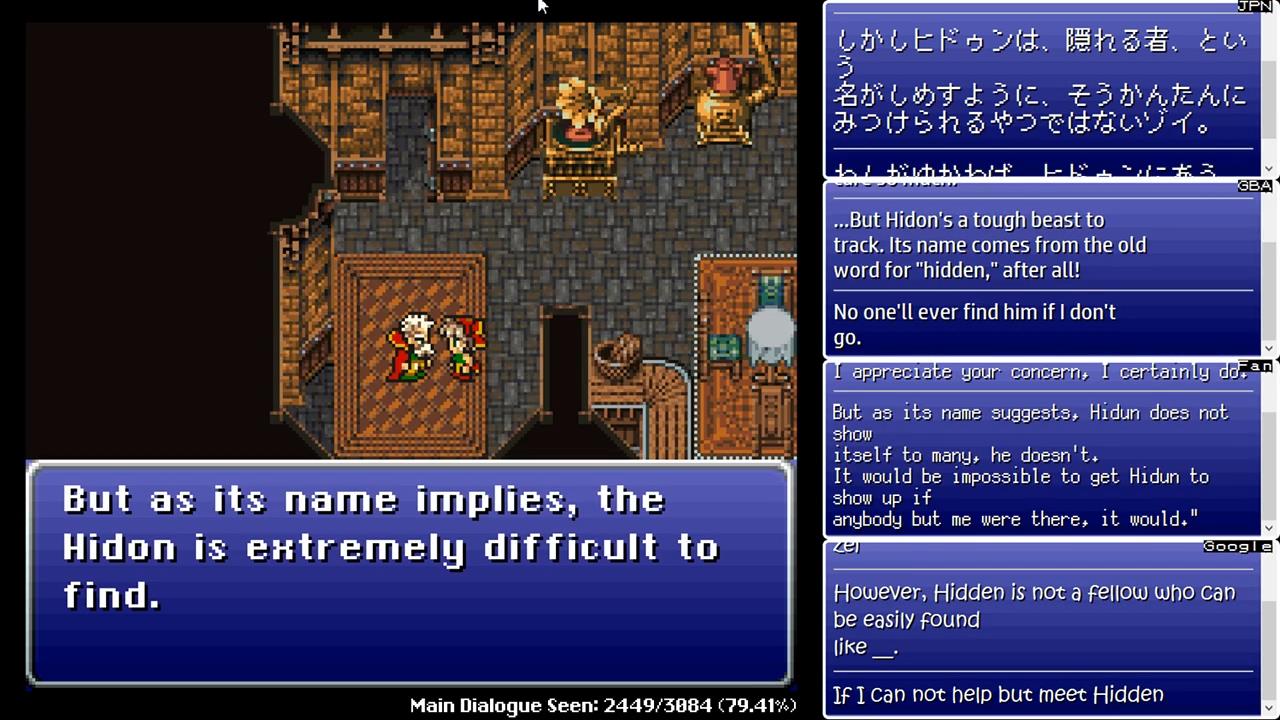
Strago and his friend have been searching for a legendary monster for a very long time. In Japanese, this monster is known as ヒドゥン (hidun). This is an unusual spelling in Japanese, but it’s actually a common way to spell the English word “hidden”:
The Japanese script also adds an explanation about the name:
But as the name Hidden – which means ‘hidden one’ – suggests, it’s not easily found.
Calling a legendary, hard-to-find monster “Hidden” would sound unimaginative and pretty on-the-nose in English, and having to explain that “Hidden” means “hidden” in English makes no sense. So the Super NES translator renamed the monster “Hidon” and changed the explanatory note to say:
But as its name implies, the Hidon is extremely difficult to find.
The GBA translation retains the “Hidon” name change but changes the explanation into:
But Hidon’s a tough beast to track. Its name comes from the old word for “hidden,” after all!
During the stream, some of the chatters tried to come up with alternative localized names for this monster. I forget what they were, but if you have any fun ideas of your own, share them in the comments!
In the Kisser
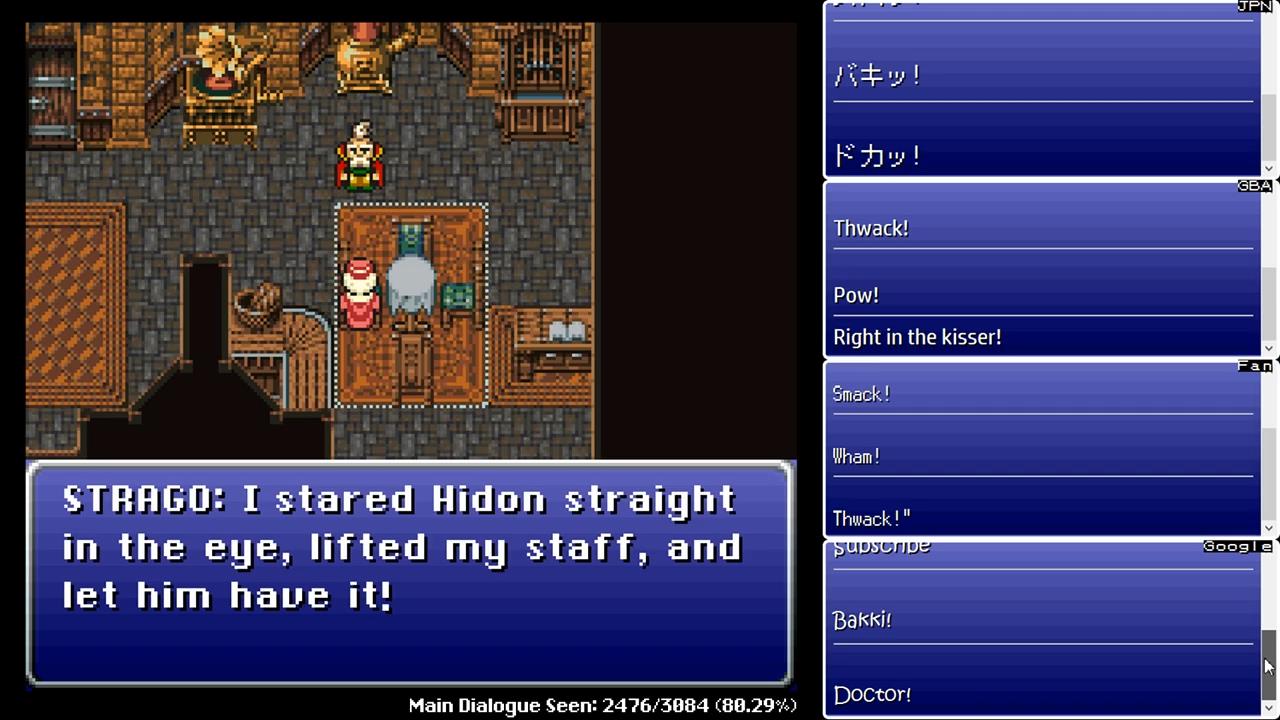
Strago finds Hidon, defeats it, and returns to brag about it to his friend. In Japanese, he tells the story in an over-the-top way that culminates in him saying stuff like: “Bam! Bash! Thwack!”.
The GBA translation inserts “Pow! Right in the kisser!” into the scene, which is a reference to the old The Honeymooners TV show. Unfortunately I can’t find a clip of it online, but it’s one of the most famous quotes from the show.
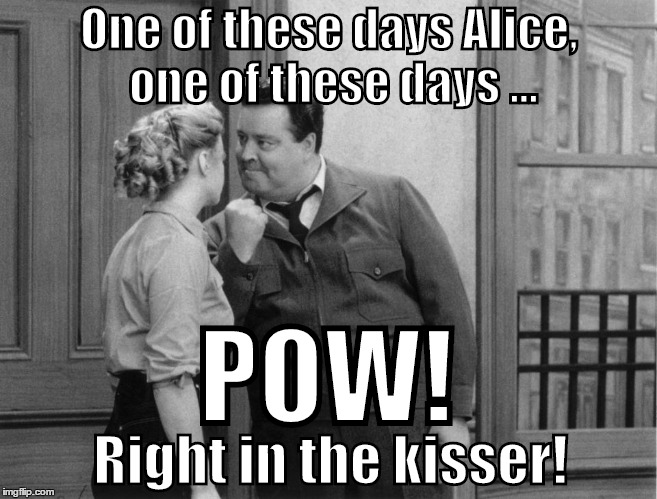
It’s not as blatant as the Three Stooges reference we just looked at, but it definitely had people groaning during the stream.
Losing It
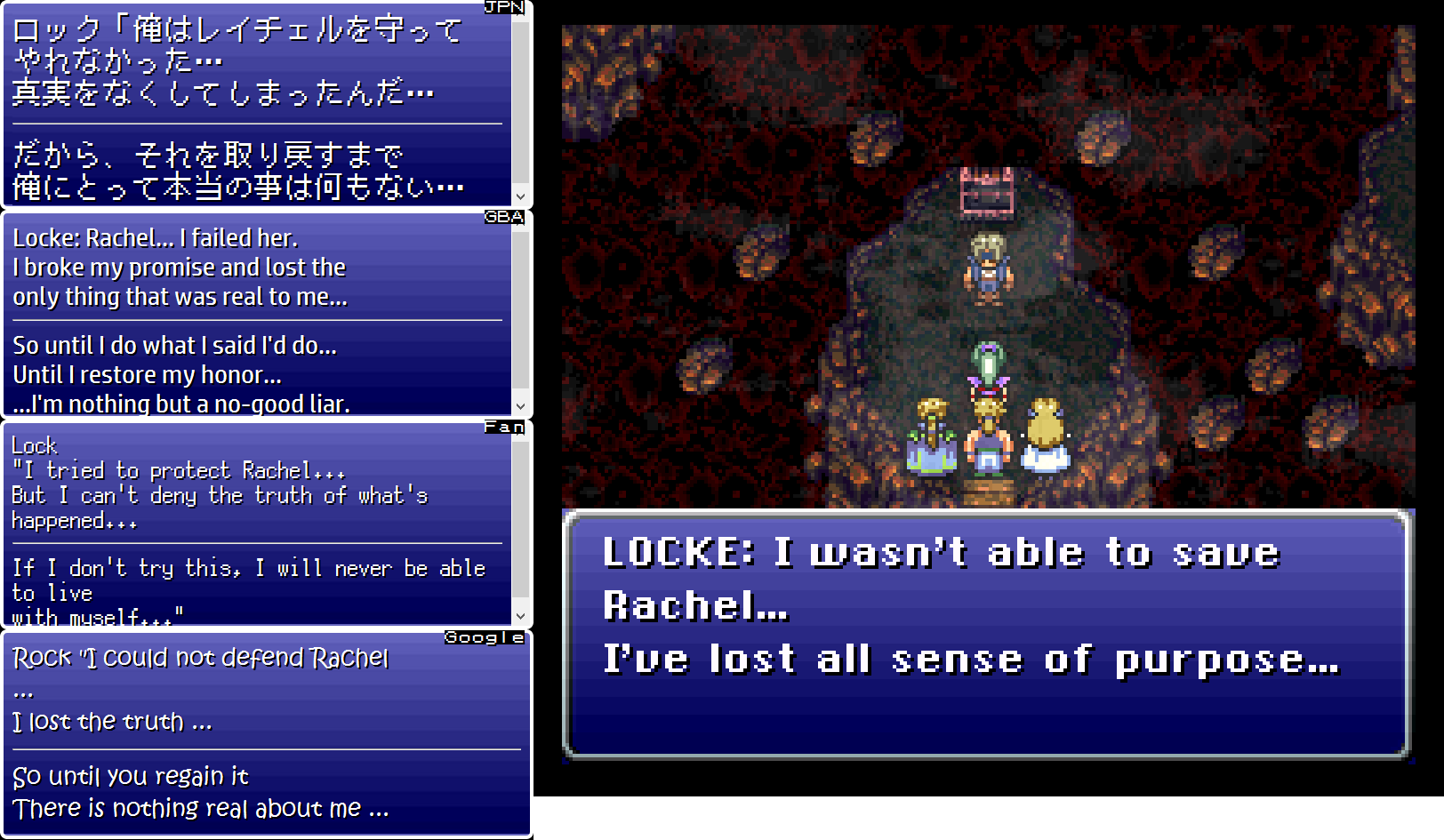
The heroes find Locke deep inside a cave. He’s finally located the special treasure that can bring his old girlfriend back to life.
In Japanese, he says at one point:
I wasn’t able to protect Rachel… I lost the truth. So nothing will ever be real to me until I get it back.
This is a strange line that sounds even stranger in translation. Each translator dealt with it differently, mostly by changing the text or writing around it:
| Super NES Translation | GBA Translation | Fan Translation |
| I wasn’t able to save Rachel… I’ve lost all sense of purpose… | Rachel… I failed her. I broke my promise and lost the only thing that was real to me… So until I do what I said I’d do… Until I restore my honor… I’m nothing but a no-good liar. | I tried to protect Rachel… But I can’t deny the truth of what’s happened… If I don’t try this, I will never be able to live with myself… |
In the Super NES version, Locke blames himself for what happened to Rachel and has lost his sense of purpose. In the GBA version, he blames himself and is hung up on his honor and keeping his promise to Rachel. In the fan translation, it sounds like he comes to terms with his failure and hopes to use the treasure to make things right for his own sake.

Of course, this is all open to interpretation, but it’s at least clear from the Japanese line that Locke does have a sense of purpose, meaning the Super NES line is incorrect.
Inner Person

Before Rachel disappears for good, she tells Locke in Japanese:
Give your love to the person inside your heart.
The Super NES translator seems to have taken “the person inside your heart” to mean Locke himself, as the translation is:
You must learn to love yourself again, and regain your self respect.
The GBA translator saw it as meaning an external person, which we can assume is Celes:
Give your love to the one who now dwells within your heart… Love her… as you loved me…
As we can see, the GBA translation also added some extra lines for extra clarification that it’s a woman being referred to.
The fan translator misunderstood the line and a significant portion of the entire scene:
I loved you, with all my heart.
In all, this is a nice example of how a translation is shaped by the translator’s understanding of the source text. Each translator understood the line in a different way, so each translation wound up substantially different. Personally, I agree with the GBA translator that Rachel is telling Locke to let go of her and give his love to the other woman he holds dear.
Cursed Shield
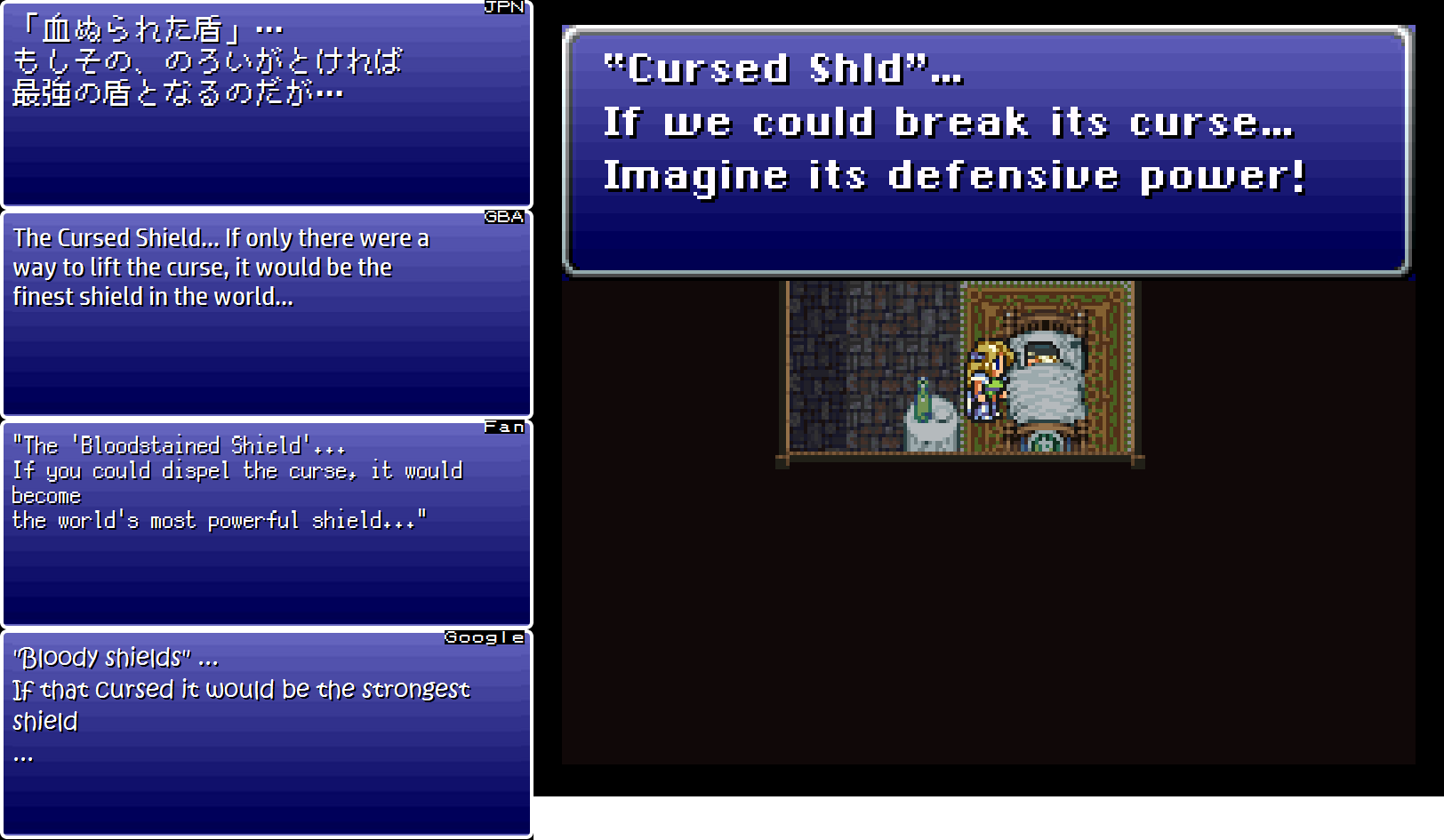
There’s a terrible shield in Final Fantasy VI that no sane person would ever equip, as it causes a bunch of status ailments all at once to anyone who wears it. But if you win 255 battles with the shield equipped, it transforms into the most powerful shield in the game.
In the Japanese version, this shield is known as the “Bloody Shield” or “Blood-Smeared Shield”. This was changed to “Cursed Shield” ( technically “Cursed Shld”) for the Super NES translation, since the blood reference might’ve led into NOA trouble territory. The GBA translation retains this name, and the fan translation reverts it back to “Bloodstained Shield”.
In all versions, the game says that the curse on the shield has been broken after 255 battles. But now that I think about it, maybe the Japanese name also implies that you’re slowly washing the blood off the shield over time, and that’s how the curse is specifically broken? I decided to look through all my Japanese guides but strangely enough I didn’t find anything about uncursing the shield at all.
Odin Loses
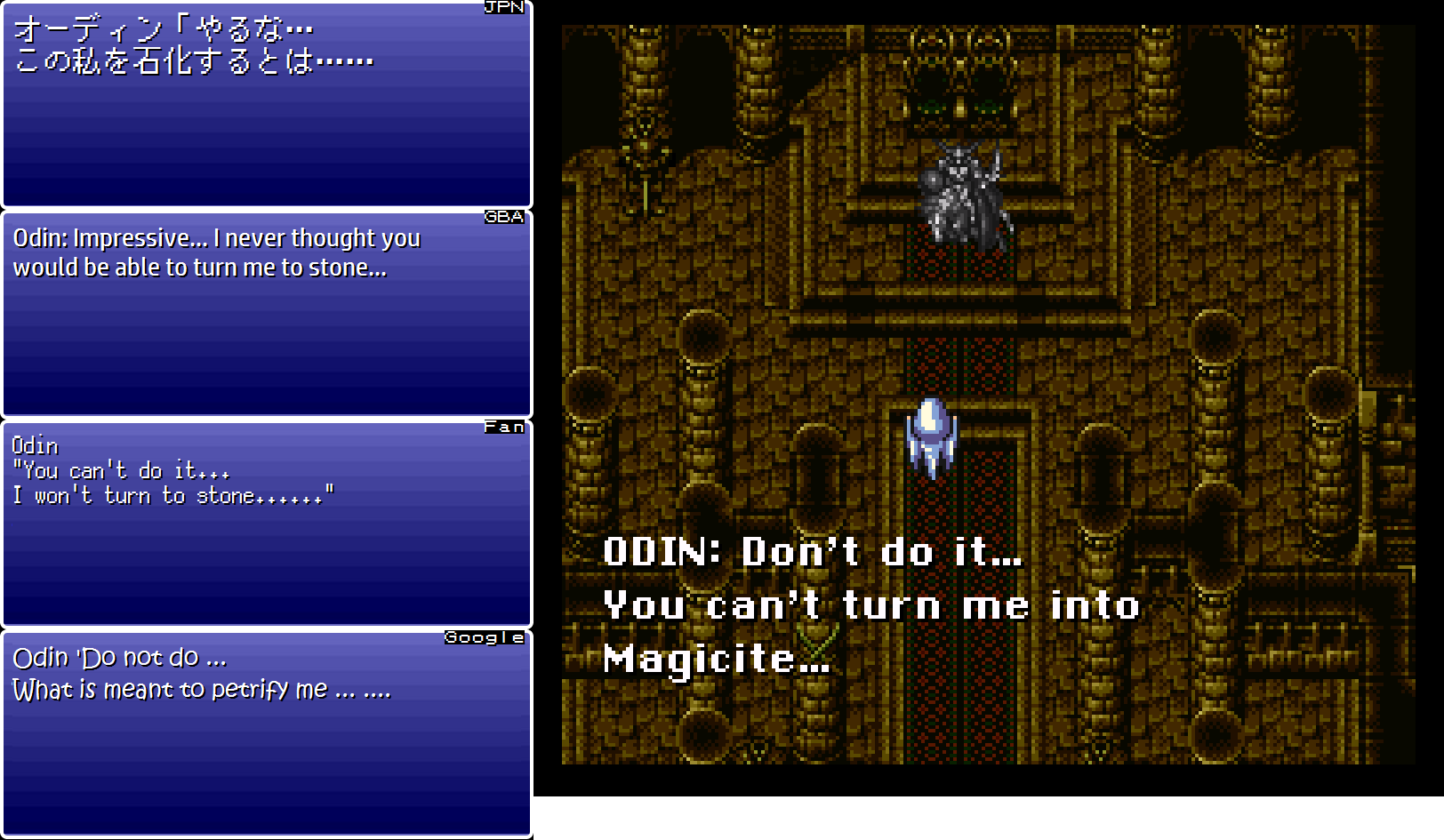
We see a flashback in which Odin fights a monster but loses and gets turned to stone. As he turns to stone, Odin says in Japanese:
Impressive. To think that you could turn me into stone…
The Japanese text is short and simple, yet tricky to translate if you’re not careful. I discuss the cause of the problem during the stream, but basically the first sentence can mean “do not do it” or “you’re pretty good/you’re impressive”, depending on the situation and intonation. Most experienced translators would be able to instinctively tell that the latter meaning is intended here, just from these two sentences alone. It’s also exactly the kind of tricky question you’d find on a professional translation test when applying to a translation agency or a company.
We see that the Super NES translation gets both sentences wrong. The translator misinterpreted the first line and mistranslated the second line. We literally see Odin turning into a stone statue during this scene, so my guess is that the translator was translating this scene without context and without anything to reference.
The fan translation makes similar mistakes, but I can’t tell if it’s because it’s a rewrite of the Super NES line or due to similar misunderstandings. Even the Google translation falls for the “do not do it” context trap. Only the GBA translation properly translates everything here.
Forbidden Love
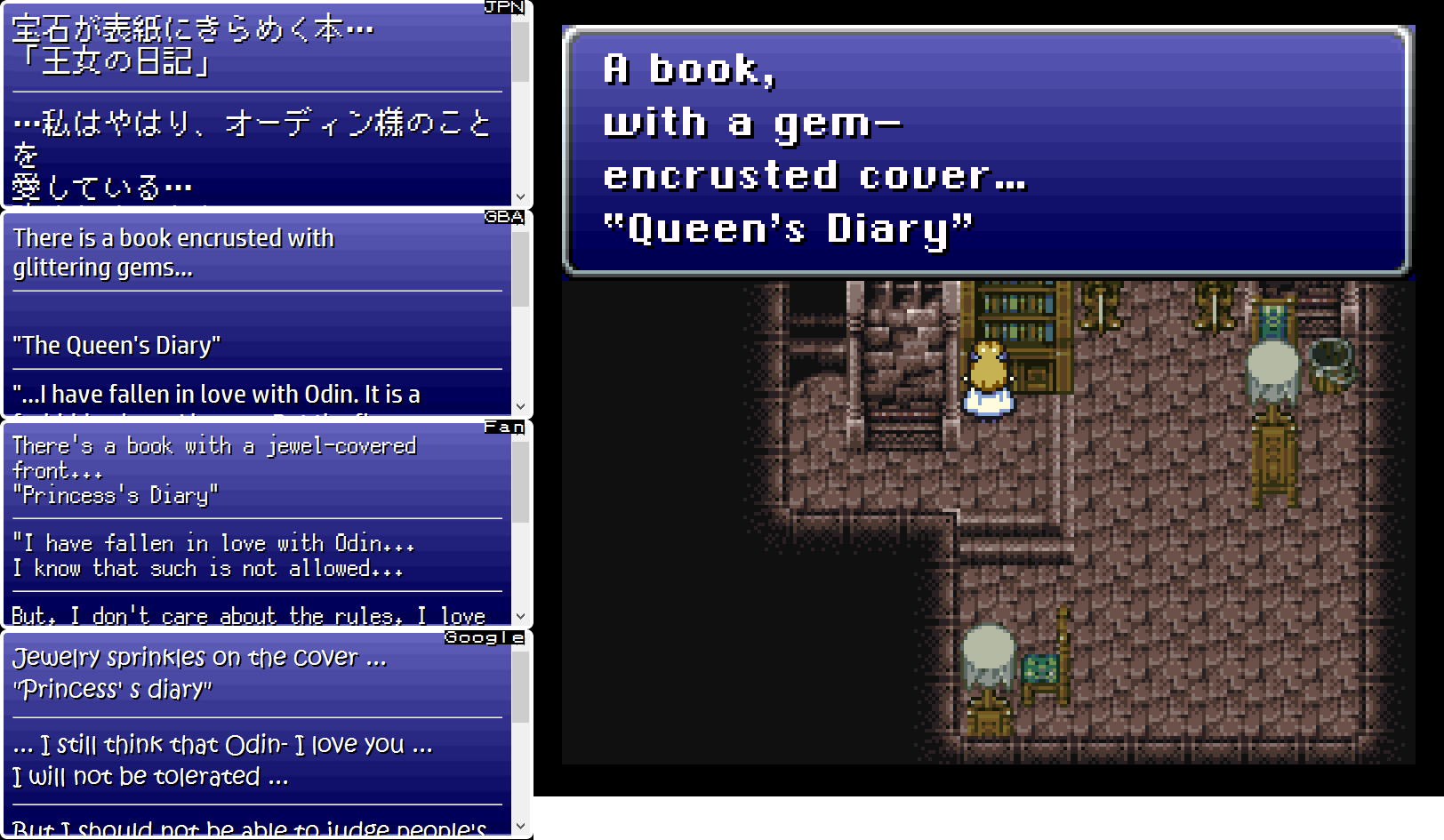
There’s a secret diary in which a royal woman records her secret, forbidden love with the Esper Odin. In Japanese, this woman is identified as a princess. In the Super NES translation, she’s instead identified as a queen.
This change seems minor at first, but the Super NES version implies in part that the love is forbidden because it means the queen would be having an affair behind the king’s back. But the Japanese version solely implies that the love is forbidden because it was unthinkable for a human and Esper to be together. Even more so if that human is a princess.
The Japanese word used here is 王女 (ōjo, "princess, royal daughter"). The word for queen is 女王 (joō). The two words look very similar and are easy to mess up, especially if you’re translating quickly. It’s very possible that’s what happened here. Either that, or “princess” was replaced with “queen” to make a puzzle involving the throne room a little easier to solve.
Whatever the case, the GBA translation uses the “queen” choice as well. Only the fan translation and Google translation keep the princess a princess.
We didn’t see it during the stream, but apparently Terra will say an extra line if she’s in the party: “Love between a human and an Esper….”.
Secret Sword
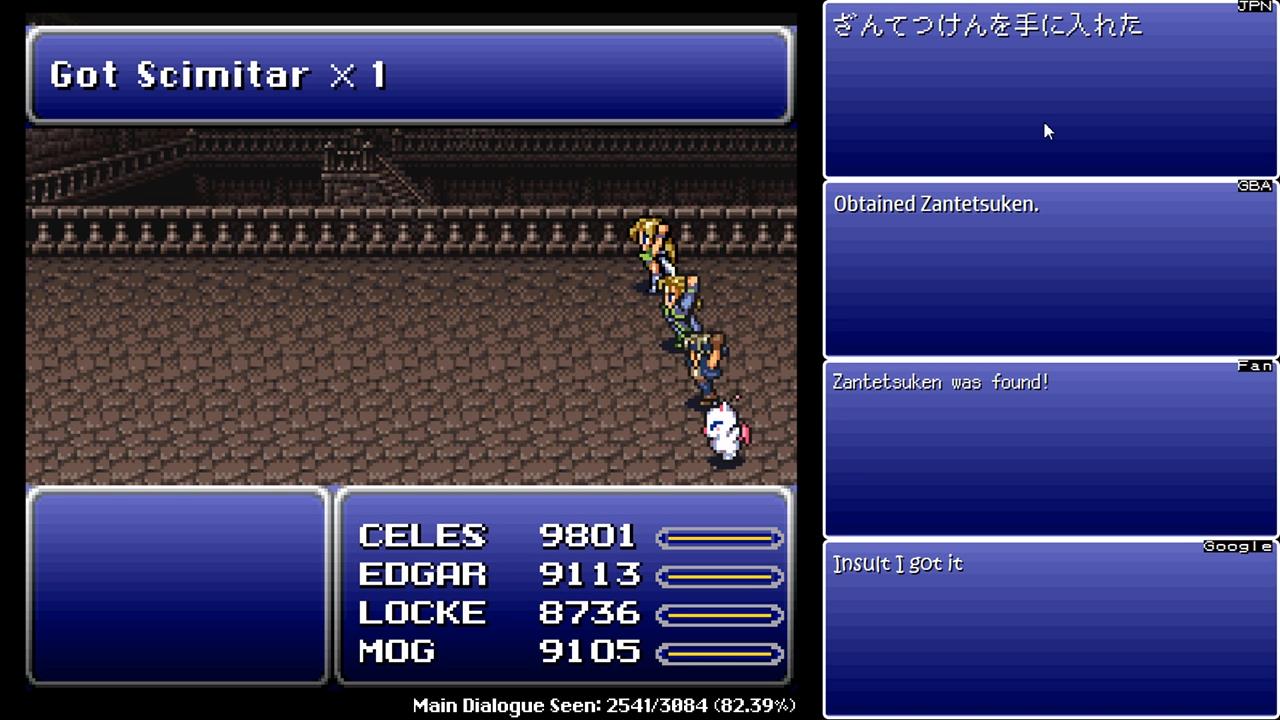
You can get Odin’s sword by defeating a monster in a secret chamber. In Japanese, the sword is known as the 斬鉄剣 (zantetsuken, "iron-cutting sword"), which appears in a lot of Japanese entertainment. It’s also a recurring name in the Final Fantasy series and is usually connected to Odin in some way.
In the Super NES translation, the Zantetsuken is first called “Atom Edge” during a flashback scene, and is then called a “Scimitar” when you obtain it. Later Final Fantasy games kept the “Zantetsuken” name as-is during translation, however:
Incidentally, Zantetsukens are an actual, historical thing and you can buy them given enough money, effort, and luck. Here’s a good start if you’re interested!

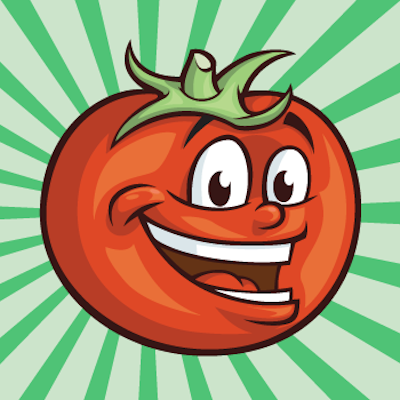
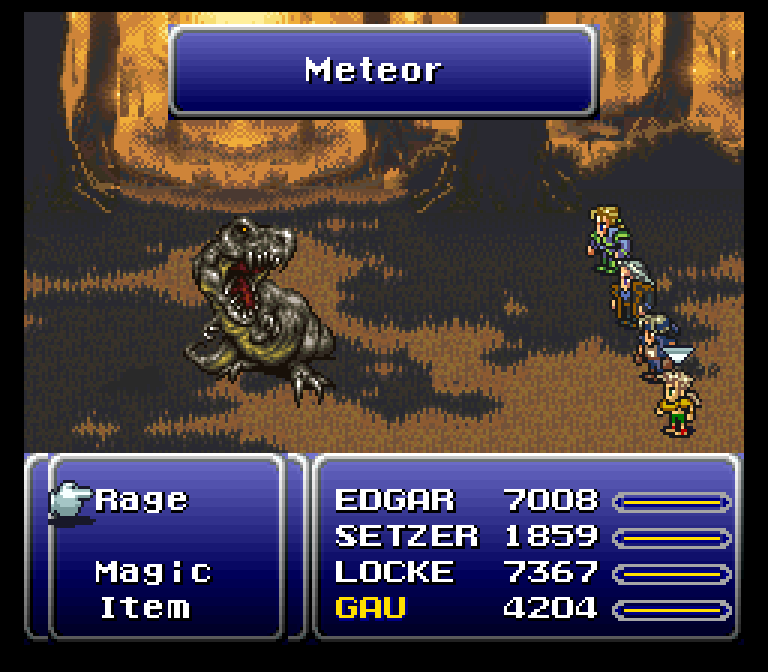
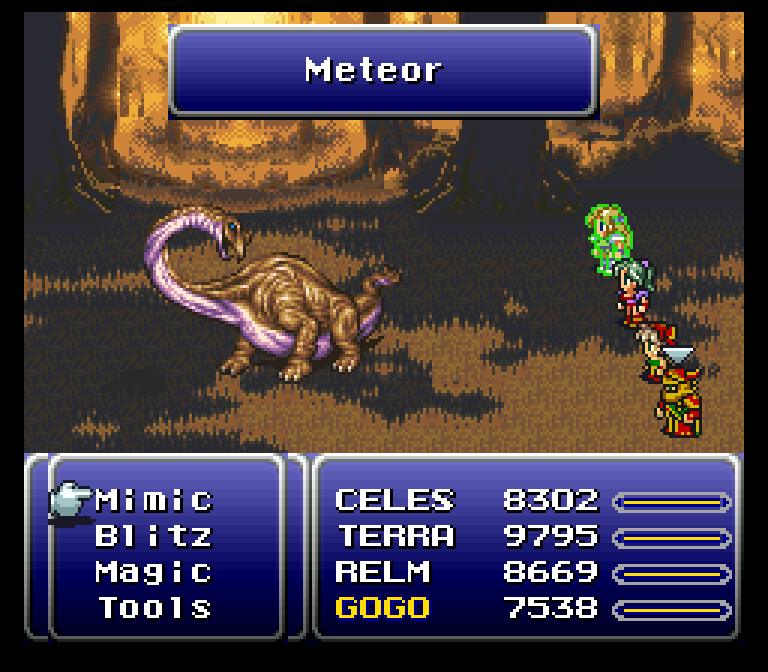
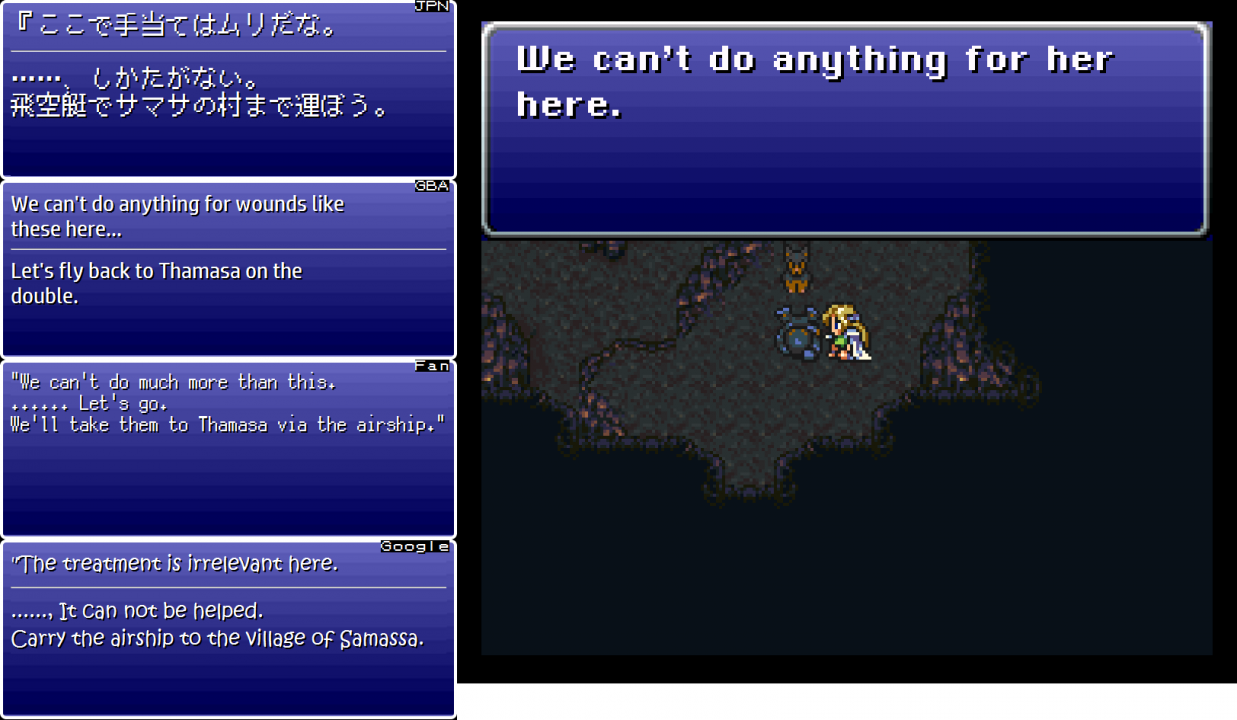
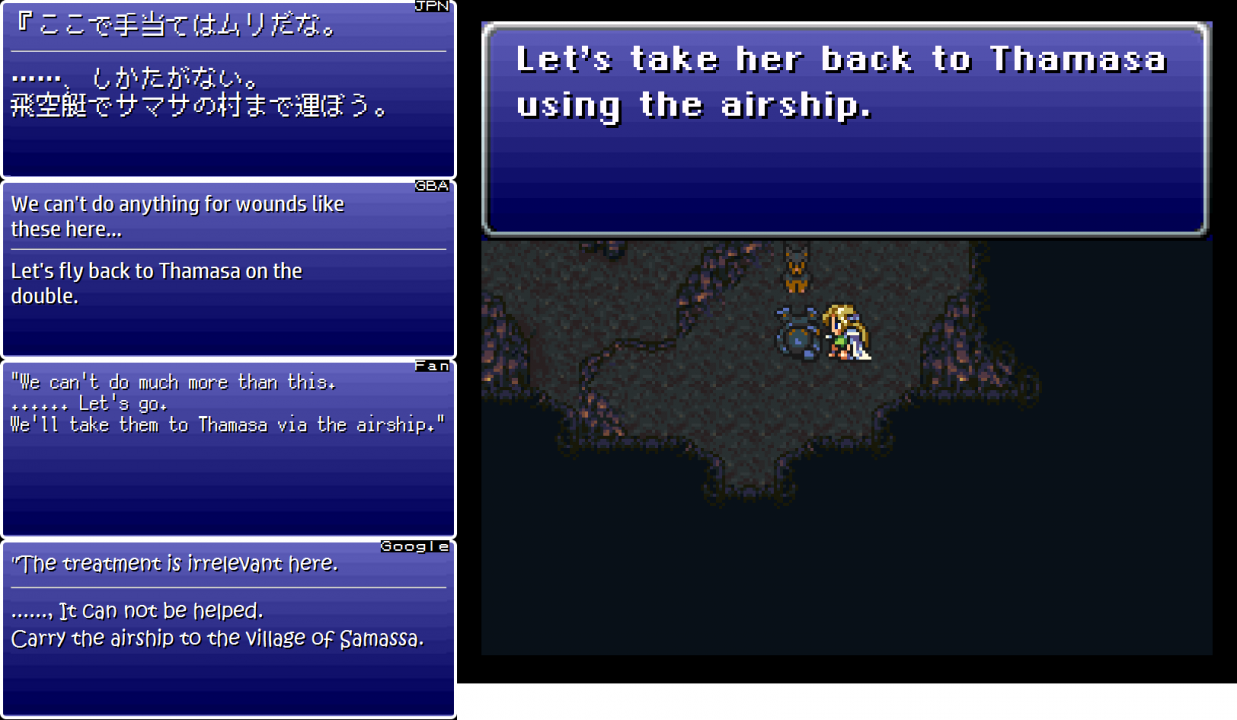
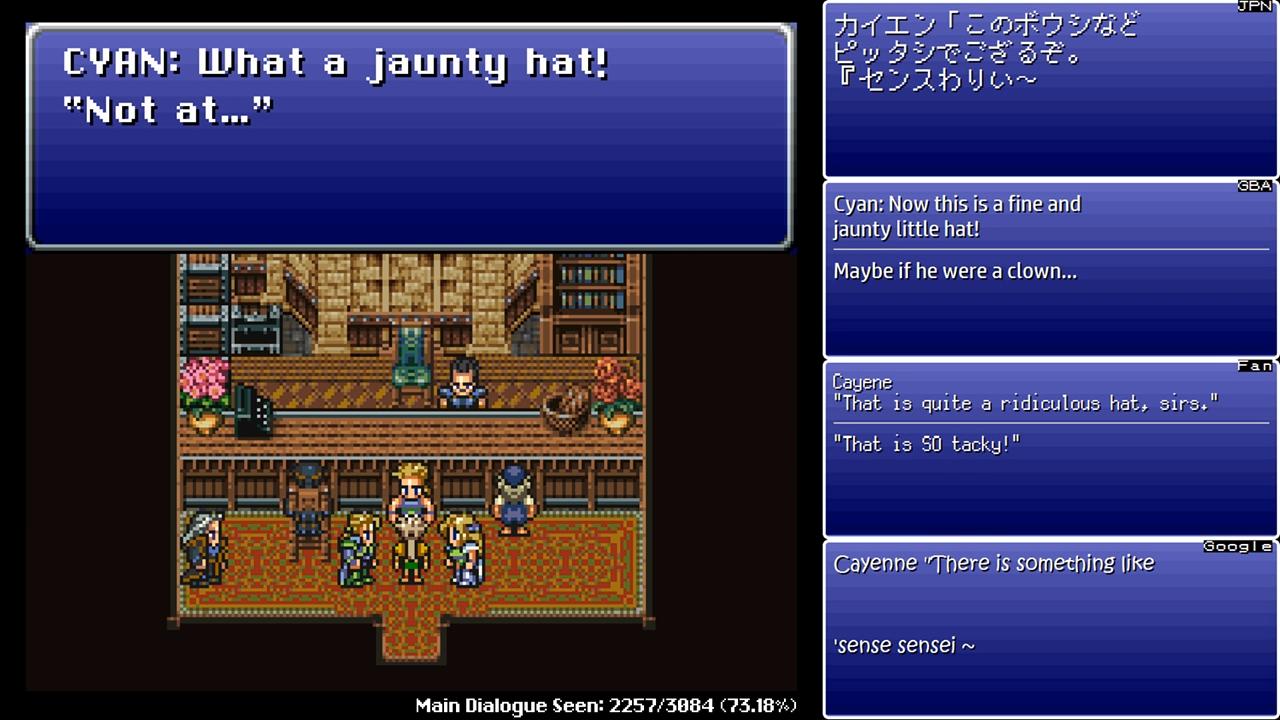



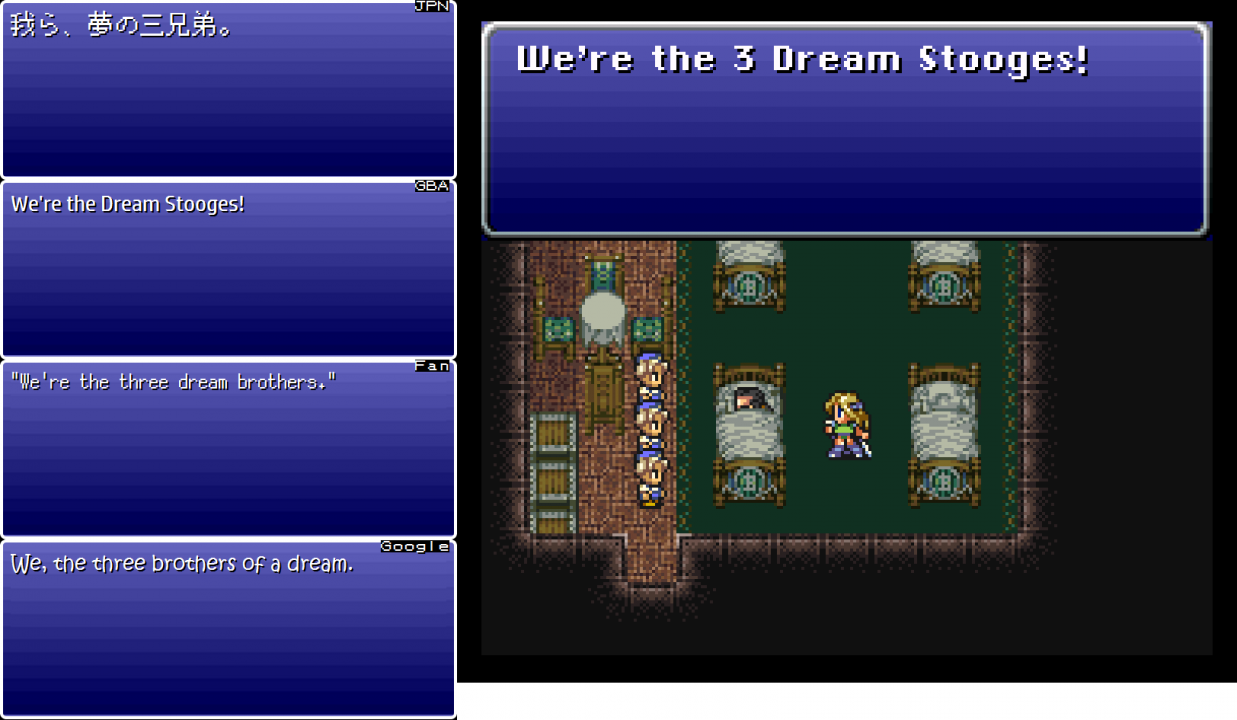
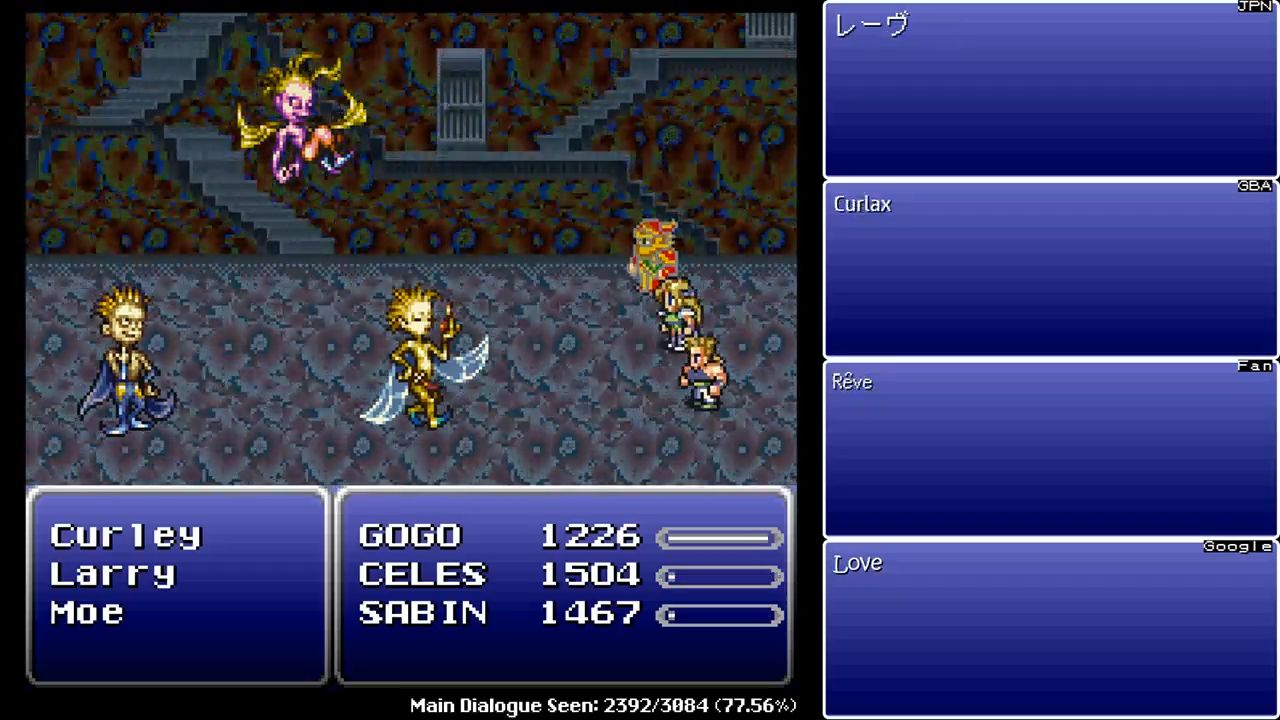
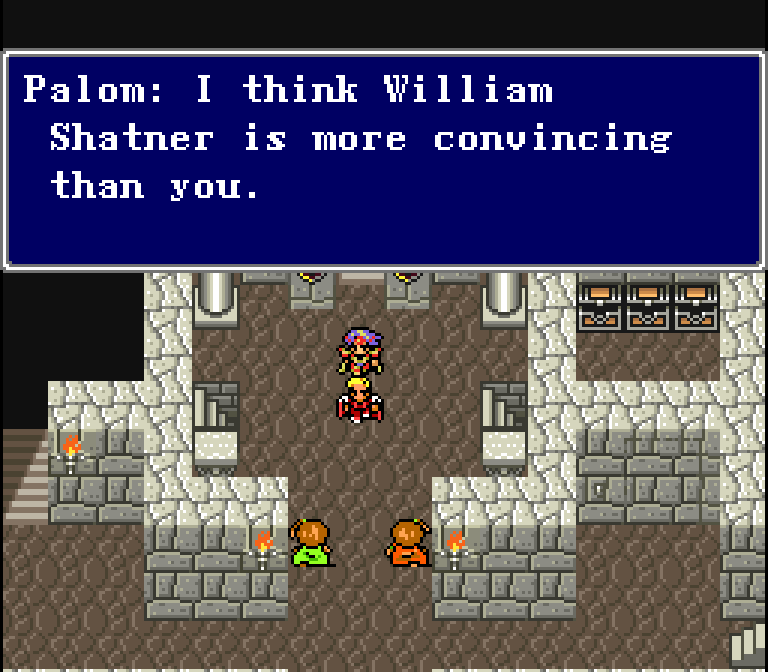

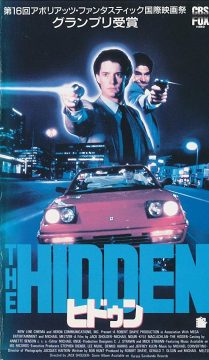

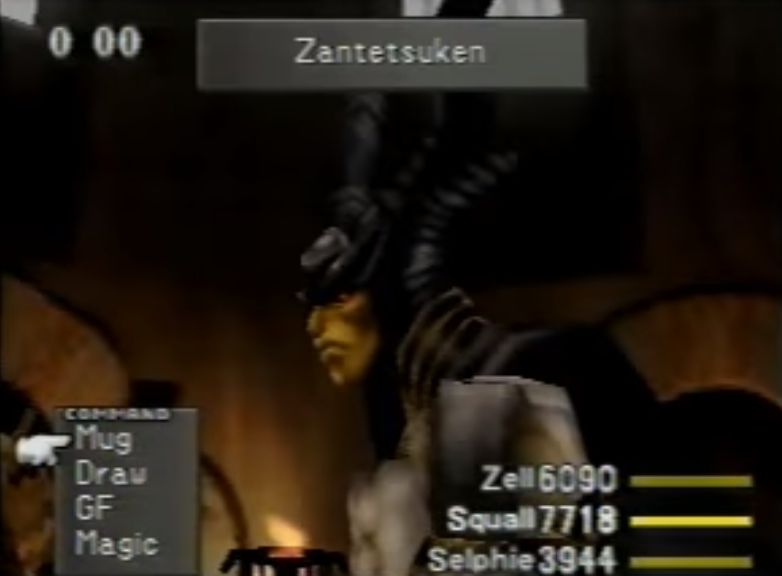
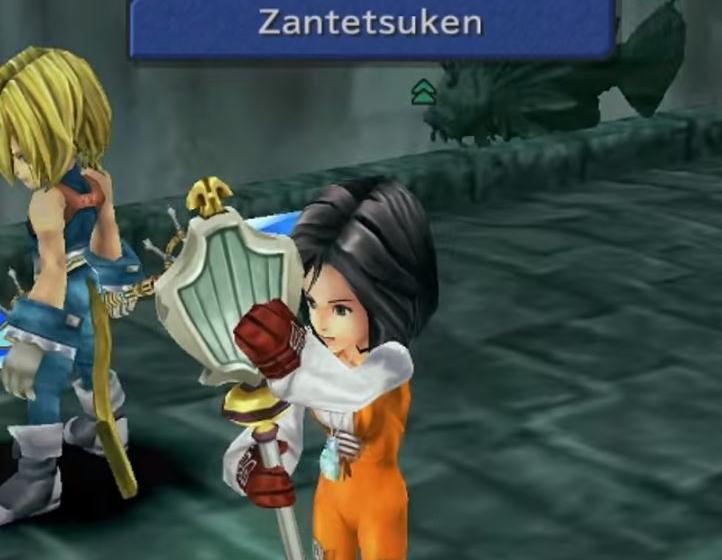
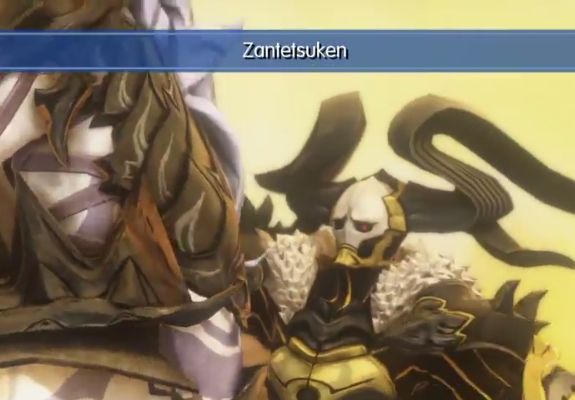
![press start to translate [Final Fantasy IV] press start to translate [Final Fantasy IV]](https://legendsoflocalization.com/wp-content/uploads/2019/08/bbenma.png)
(Note: I haven’t proofed this or even done a read-through of it yet but I wanted to get it posted now so I can fix things up with a fresh brain tomorrow. So if you’re reading this, you’re an early bird who gets to see my bumbling mistakes!)
MOEbious is a very blatant reference to Moe from the Three Stooges, they just made the names a bit less obvious.
Oh, I know – in the previous paragraph I mentioned that the names are the Stooges but changed up.
Moebius/Mœbius is the name of a famous French comic artist as well who should be pretty well known in Japan. This seems like a copyright-avoiding change.
I felt like each of the three “Dream Stooges” names in the GBA version was an attempt to marry the intended Dream motif with the Woolsey Three Stooges motif. Moebius = Moe + Morpheus/Morbius, Virgil’s demigod of sleep. Curlax = Curly + Snorlax, as you said. Larragorn is the what that doesn’t make any sense. I guess the GBA translator couldn’t think of a Larry + sleep pun.
Has this project been canceled? Been many weeks since the last update
No, it’s still going to be a while until I can get the final pages up though.
What was the first hit sound in Strago’s story in Japanese, and why did Google translate it as “Subscribe”?
It’s ザバッ, my guess is that Google Translate somehow mixed it up with サブ.
An alternative translation to Zantetsuken would be “Iron-Cleaver.” Also, if they absolutely wanted to avoid “death” in “death penalty” something of similar ominous magnitude could be “(final) doom/verdict/judgment”?
The whole dragon/dinosaur issue gets extra messy when the palette swaps of those forest dinosaurs are named “Something Dragon” in the Japanese game. Even one of the eight legendary dragons are a palette swap of the Tyrannosaurus, known as the Earth Dragon in the Japanese game.
Yup. It’s probably because the whole idea of whipping up stories about dragons came from researching dinosaurs. Still, dinosaurs aren’t dragons and never will be, so it’s a wonder why Japan always does this.
I kinda liked finding out that the “dragons” they were talking about were dinosaurs. It seems reasonable to me that ignorant starving people would see giant terrible thunder lizards spitting magic meteors at them and conclude “that’s a dragon”. What else would they think to call it? In fact, why even have the distinction between dragon and dinosaur in a world like that, where they’re both real?
Agreed.
I think it’s more a sort of hindsight wig-out that makes people concerned about this, because they either remember or have heard about the days when nutty rumors and urban legends about this and other games ran wild on Internet discussion boards.
I was around and online in those years, and I’m not entirely sure why they were such a bad thing. I certainly never understood the empty fetishism of “faithful” translation, whatever that would even mean.
Some of the deepest and best elements of the stories of games I played back then, especially games from Square, turned out to be the result of either muddled translation during localization or creative license by the English script-writers. I wouldn’t have found the climactic battle of Chrono Trigger nearly as exciting or interesting without the revelation, apparently not to be found in the Japanese script, that Lavos hadn’t just been killing the planet to breed its spawn, it had been guiding the evolution of all life on the planet, meaning all the heroes, all their ancestors and descendants, their families, friends and even most of their enemies had been treated as no more than the corrupted organelles of a cell hijacked by a virus. That gave the heroes something to prove beyond just their ability to survive: that they were more than Lavos, the ultimate parasite, meant for them to be. It made me care a lot more whether they won or lost, and made it matter a lot more that, win or lose, they were fighting at all.
Whoever added that line, for whatever reason or lack thereof, contributed greatly to what that game’s story meant and could mean to the player.
And as for the environment those messier, less exactingly informed times grew around them, the wild rumor mill that resulted was a lot of harmless fun… I mean, for Pete’s sake, they’re just video games, right?
@”beat the child”: Since the game says “obutte”, it seems the translator confused “oburu” with “butsu”.
@three stooges and Honeymooners: I seem to be relatively tolerant of pop culture references in translations. It helps that the game already has the Yellow Cherry thing, so I don’t find it TOO out of place.
@Odin: Maybe when he says “you can’t turn me into magicite”, he means “can’t” as in “doing that is a bad idea”.
All these years I’ve been associating Allo Ver with soothing skin lotion. Now things make a little more senzu beans.
Television commercials always make it a point to display wedding rings when children are involved or discussing sexy stuff like Viagra. I wouldn’t be surprised if Nintendo inherited these mores in their policies, which would lead to Duane becoming a husband.
The main theory about Gogo was that they were Setzer’s dead friend Daryl, because she crashed the Falcon “in a far off land”. This was, of course, before people played FF5 and realized he was from there.
I remember one of the rumors about Gogo from back in the day. It was rumored that Gogo was actually Daryl, who must have crashed her airship into the triangle island and was eaten by the ZoneEater, and that if you traveled around enough with both Setzer and Gogo in your party, there would be a cut-scene at the end of a battle in which Setzer would confront Gogo and ask if he was Daryl. Gogo would remain silent.
I don’t know why this rumor existed or where it came from, but Gogo’s apparent lack of gender must have been a part of it.
Dinosaur is scientific pseudo-Greek for “terrifying lizard,” right? It’s cool that the Japanese word preserves the meaning so closely instead of just taking a loaner.
I’ve heard that “deinos” is closer to “awe-inspiring”.
Tyrannosaurus means ‘terrible lizard’, which I believe might be what you’re thinking of.
No, “terrible lizard” is pretty much correct for “dinosaur”. “Tyrannosaurus” is “tyrant lizard”. It’s right there in the name!
I suspect that if that Relm/Shadow scene had originally been written in English, it would have two separate sets of lines, one for Relm and one for Shadow. But a solution like that would involve changing the programming, not just the text, and a translator in a big project wouldn’t necessarily be in a position to make that happen.
One thing on Gogo: on the Status Screen when you can choose his battle menu options, you see a weird yellow coloration that looks like a glitch. In fact, its the bottom row of pixels from his profile picture. I’ve seen a few fan patches fix it, but I always thought it was some weird yellow dart.
Gogo is male? The chances of him being Adlai Stevenson went up!
On Gogo – there’s an unused shop price modifier that gives you a discount/markup based on the leading character’s gender. Gogo is treated as male.
https://tcrf.net/Final_Fantasy_VI#Unused_Shop_Price_Modifiers
Blood Shield is possibly a reference to an unused item of the same name in FF5, rounding up a set of “cursed” items of Bone Mail, Thornlet and Cursed Ring.
https://tcrf.net/Final_Fantasy_V#Unused_Items
Off topic, but FWAK/FF3BOGUS, an ancient collection of FF6 rumors had a field day with Cursed/Paladin shield, providing 2 entire sets of uncursable equipment. That will supposedly let you recruit Cecil at the Colosseum. Oh, and if you move Gogo to the World of Balance with opera raftets rats glitch, he’ll go isane and turn into an aletlrnate final boss. It also makes fun of Siegmund’s name inconsistencies by having him battle you several times under different names before joining you. As both a character and an esper. Quite a read, really.
https://groups.google.com/forum/m/#!topic/alt.games.final-fantasy/St45myd6QRE
I think there also was theory about Gogo being the emperor who had somehow managed to survive?
Either way, Gogo has no real backstory, he seems to be cameo of FFV boss Famed Mime Gogo who threw himself into the void after the boss battle.
Check your video again at 44:35 – you didn’t suplex your train of thought when it told you the SNES version omitted the sound effects :P.
I read about one TCRF Research of Final Fantasy VI, and it says that Gogo is treated as a male by the game system, take a look on the “Unused shop price modifiers”
This is more trivia than anything of severe consequence. Even if something like that could somehow override ambiguity in the story itself, the script you’re talking about is, as you acknowledge, unused in the final game.
Oh please, what ambiguity? Gogo is clearly a guy. Keep in mind that there are only three playable females and the armor classifications are set for them. Don’t go preaching in the name of that crowd or whatever you’re doing.
The only Gogo theory that matters is the one where he’s Adlai Stevenson. https://kotaku.com/that-time-a-player-claimed-final-fantasy-vis-gogo-was-t-1790014241
I’m so glad someone mentioned this! This joke is my childhood!
Didn’t see anybody mention yet that Famed Mimic Gogo in FFV counters with a meteor attack, and FF6 Gogo’s desperation attack is a meteor attack. There shouldn’t be any confusion about who he is at this point.
If it were me, I’d’ve picked something Germanic or Celtic or heck, maybe Latin, for Hidon’s name
But , that’s just me
Still Life makes far more sense than Nara Camicie. Some of the development staff needed to learn not to bring the real world into games. It’s actually pretty juvenile and unprofessional on their part.
Oh, yes, unprofessional and juvenile. We need to treat a game with a talking white stuffed toy and a wisecracking octopus with the utmost respect reserved for the holiest of texts. No fun allowed in this game!
But seriously, though, I really would love to know where half of these monsters came from. We’ve been speculating for decades on what the gamedevs were thinking with those monster names. Having to also deal with cultural mistranslations and misunderstandings both ways and back just adds to the confusion.
I thought I remembered one of the gamedevs outright acknowledging that Malboros are named after the cigarettes that give you bad breath, but now I can’t find it.
Not only did they not admit that, it’s also pretty obviously not true considering these things aren’t named Malboros in Japanese, but “Moruboru” (モルボル, which looks absolutely nothing like how Malboro is written in Japanese (マールボロ).
The Japanese FF wiki mentions it, but just as “moruboru are called Malboros overseas, and it appears this name is commonly thought to be taken from the cigarette brand Marlboro”. Considering the general quality of FF7’s translation and its handling of monster names, I’d say it’s probably more likely to be a coincidence, though.
According to the wiki, Akitoshi Kawazu has been quoted as saying “well, it has this moruboru-feel to it, doesn’t it?”, which is the closest we have to a name origin.
It’s also possible that there’s some wordplay going on with a registered trademark that the team knows to keep among themselves.
In any case, it’s not as though the meaning of any element of fiction or art is dictated or overridden solely by what the creator says or doesn’t say after the fact about their intent. “Word of God” is not a real thing.
“Oh, yes, unprofessional and juvenile. We need to treat a game with a talking white stuffed toy and a wisecracking octopus with the utmost respect reserved for the holiest of texts. No fun allowed in this game!”
Looks like you need to do some growing up from that childish sarcasm, Hermoso. : /
In regards to Hidden/Hidon: in Kingdom Hearts, where the bad guys are called “Heartless” even in Japanese, there’s an infamous line where the English version says “Heartless – those who have no hearts.”
How is that infamous?
It looks very “people die when they are killed”.
People make a big deal about the most trivial things in media, I swear.
But… both statements are true, are they not?
Ooh, this is a great topic that definitely deserves its own article someday. I run into it from time to time in my own work but I’m having trouble recalling what they were. I wonder if there’s a list out there on TV Tropes or elsewhere.
There’s another one of those here: https://imgur.com/a/g6f8y
“A medical student…?” “That’s a student who studies medicine.”
“A hospital…what is it?”
“It’s a big building with patients but that’s not important right now.”
TV Tropes does have a list, The Department of Redundancy Department
https://tvtropes.org/pmwiki/pmwiki.php/Main/DepartmentOfRedundancyDepartment
Mato, why did you do 12 posts for the WoB and just 2 for the WoR? Your playtime doesn’t seem to be significantly shorter for the WoR. Why the decision to condense two and three streams into just two written posts?
I ask because I’m wondering if you think that the WoR translations just don’t have that many interesting things to highlight. A lot of the game’s fans seem unsatisfied with how the story falls apart and loses linearity in the WoR, so maybe the translation choices are related?
I discuss it during the streams, but it’s because I could tell I was on the verge of burning out on the project and also because I need to finish it before the end of this month. Even so, I’ve been trying to make sure I pack each WoR update with as much as I can manage.
There’s also still going to be another article for the WoR, but discounting that only 20% or so of the text is from the WoR while 60% was from the WoB.
Originally I wasn’t planning on doing these big article writeups in the first place – the streams were intended to be the main thing and these were supposed to be simple bullet list summaries. But now my 1 month project has turned into nearly 4 months :O
Oh, wow, I had no idea you meant to do the whole thing in one month!
I have only briefly glanced at the recorded streams, but these writeups have been a delicious treat for me. For the past few months, I would be eagerly checking up every week or so to see if there was another post from you, like a kid waiting for Christmas morning. It’s been fun and educational to see you simultaneously compare three different translations (and also impressive that you wrote software to help you do this).
It’s also very helpful for a fan adaptation I’m working on! Thank you very very much!
This site offers RSS for instant updates, though I realize hardly anyone uses RSS. Feeder is a convenient browser plugin.
Thanks for going to the trouble of grammar explanations with some of the mistranslations, Mato. Some of this stuff, like やるな and のどこが are stuff I never learned anywhere. I take notes every time I read these!
XのどこがY? makes more sense to an English speaker if you think of it as meaning “what part of this?” (So in this example, “What part of this is a folding fan?”).
Would you mind correcting the error in your article before it’s completely overlooked? I referenced it earlier. Thanks.
Thanks, I fixed it. I had forgotten about it because I was confused and thought you were talking to someone else or posted on the wrong article, since there are three videos this time and not just one.
Happens to the best of us. Thanks. 🙂
> Japanese is full of words that sound the same but have very different meanings. This includes the word sake, which can mean “alcohol” or “salmon”.
Can I nitpick? These identical words like “ame” “hashi” “sake” are written the same, but when you read them they don’t sound the same. They have stresses (called pitch accents) on different syllables.
I think it’s “sa-ke” unstressed for salmon and “sa-KE” for alcohol, but it can be different in other dialects. And this never gets written down so you gotta just imagine it.
I never thought that the Queen’s love for Odin was forbidden because she was cheating, but just because he was an Esper. You can have a Queen without a King, after all.
Something I always found funny was the Grand Trine screwup in FFVI. Strago’s ultimate Lore is called “Grand Train” in SNES. The translator misread グランドトライン (gurandotorain) as referring to a train, which is silly enough on its own (since the spell is clearly space-themed, not train-themed).
But the stranger part is that the new official translation is *also* odd. Officially, it’s now Grand Delta, which is cool-sounding, but it misses the important fact that the spell is actually a reference to a specific astrology term, a Grand Trine (which is a sort of triple planet alignment). Naming it “Grand Delta” completely nixes the reference.
On the other hand, aren’t trines really obscure? I think we have more exposure to deltas as triangle shapes from science class and from river deltas. If the choice of delta was a deliberate attempt to avoid exposing westerners to an obscure astrological term, I think it’s justifiable. Sometimes translators have to take into account what the audience knows instead of trying to educate the audience by replacing one foreign term with another similarly foreign term.
No matter how obscure a word might be, it is not really a translator’s job to replace it with something more common, unless there is also a bigger-scale localisation involved. Besides, if either translator would have used the term “Grand Trine”, there would not have been any replacing of terms – it would have simply been a straight translation of the original term.
He’s also kinda saying “sometimes translators have to take into account that American audiences are much dumber than Japanese audiences, so it’s justifiable to dumb down dialogue in order to avoid exposing them to words they may not know. Unlike Japanese, Americans aren’t really capable of handling such things”, which… yeah.
I don’t think he is at all. I think the significance of “trine” here is not real obvious, but the name is trying to call your attention to how they use the triangle as a recurring image for magic in the game. There’s 3 war gods, they’re from space, and magic is some sort of field that they emanate. (Strago talks about this when you go into Kefka’s Tower.) It’s easy for us to nitpick, but I don’t mind this choice at all, cause it helps the player get a more cohesive understanding of what’s going on.
He is absolutely not saying anything of the sort.
Take the chip off your shoulder. “Dumbing down” loses all meaning when the concept is ratcheted wide enough to drive that rickety truck through.
Maybe it became Grand Train because of the sound effects used for the spell. It sounds kind of like a train pulling up to the station.
Incidentally, it’s funny that FFVII got it right with the Trine Enemy Skill, even though that game was translated (poorly) to English by the original Japanese development team.
That exact sound effect leads me to believe that the name was recognized as an opportunity for wordplay in the original Japanese.
I think that for a lot of people, it’s just never as fun to acknowledge ambiguity in a story as it is to climb up on a rotting soapbox and begin to “correct” things, at the top of the person’s voice, that never needed correcting.
As someone who has never even heard of a TV show called “The Honeymooners”, I found Strago’s “Right in the kisser!” expression to be quite fitting for the situation.
You know, I always read Hidon as “high-dawn”, so I never really got the “hidden” reference. And honestly, I’m kinda glad about that; I always thought Hidon was this amazing monster that only Strago knew about. I think if I’d realized it was just stupid wordplay I might’ve not cared as much. I mean, I like puns and wordplay, but they do tend to make things feel a little less momentous.
In other news, I think it’s interesting how rumors from this game have kind of persisted over time for me. I remember many years ago I read a “FF3 Secrets and Glitches Guide” (I think I still have a paper printout somewhere) that had a bunch of “hidden” stuff in it. What’s funny is how many of those things have been referenced both here and on a glitchy LP over at the LP Archive (https://lparchive.org/Breaking-Final-Fantasy-VI/). Stuff like getting the Allo Ver rage, finding the Czar Dragon, getting the “special cutscene” with Gogo (SECRETLY DARYL YOU GUYS) and Setzer, and of course reviving General Leo (which, by the way, that LP mentions how to do; shocking, I know) all stayed around many years after being clearly debunked.
I think that’s a bittersweet thing about the modern world of gaming. That fog is all gone. Excellent comparison efforts like this one exist to remove all ambiguity about translation, and “hidden clues” just turn out to be the delusions of a rushed translation. Games can be decompiled and studied to find out what exactly was possible, what was cut, and what was intended and what wasn’t. Eventually some concept of the “right” version forms, and previous versions become laughable due to their “errors” and “cringiness.” Those of us (like myself) who hold onto a preference for a murkier time are regarded as blinded by nostalgia. And maybe that’s true.
All this to say, I kinda liked when things were sort of ambiguous (Does that make me a hipster? Is describing yourself as a hipster now outdated so saying the word “hipster” makes you a hipster?). It made things frustrating, sure (especially if you heard that getting Aeris to level 99 before the events at the end of the first disc might save her; a friend of mine actually did that), and it usually ended in failure. But there was something fun about believing the game was more than just a computer program. Aaaah well.
You’re definitely not the only one who misses the days of ambiguous dialogue and “clues” and debates about what certain lines meant.
Remember this one? “One of you is close to someone who needs help… find this person… fast.” One of Chrono Trigger’s absolutely most brilliant lines of dialogue, full of room for alternate interpretations, and it’s a mistranslation. But even as a mistranslation, it’s a thing of pure genius.
None of that should lead you to dismiss yourself as a hipster. You’re spot on, especially about the pretentious (and wrongheaded) reification of a “correct” or “original” or “canon” version of a story told different ways in different times and places with many possible meanings, and the shallow pseudo-intellectualism that reduces moving moments to “epic” ones, placed on the same shelf with snide quips breaking up goofy action sequences, and that demotes ambiguous, discomfiting and merely imperfect aspects of a story to “cringe”, a set of concepts that, properly defined, includes only itself.
Looking at the green/red ratio, my guesses for missed scenes probably are:
-The Duncan wife scene I mentioned earlier.
-Messing around in the Returner’s camp, saying yes / no gives different replies each time.
-Different party members when going to see Terra in Zozo, especially Gau.
-Different party members when going to the Opera house, including Shadow.
-Failing the Opera house in the many different ways.
-Visiting Thamasa before you’re supposed to.
-Not saving Shadow / Relm’s Dream vs Shadow’s 5 dreams.
-Let Mog die.
-The many nonstandard game overs, including the Moogle parties at the start, letting Kefka get the Esper, probably more I am forgetting here.
-Wandering around on the Empire continent before doing any Empire storyline.
-Not as many in the WoR as you’d think, but there are a few cases where a severely limited party of just Celes/Edgar/Setzer can change things.
-The ending if you never bring Terra.
Also, the final battle of Esperoid Pillar is a Kefka-corrupted combination of the Warring Triad. It’s Fiend at the bottom, Goddess in the middle, and Poltergeist at the top.
If I remember correctly, that idea at the end of your post has its origin in a strategy guide. But it certainly is one possible interpretation of those enemies, just not one dictated as the one true gospel by the game.
I’m actually a bit that the Queen wasn’t the one hot for Odin.
And I always assumed that “Atom Edge” was the technique Odin used, not the actual sword.
…and oh, Kyle Maclachlan, I didn’t expect to see YOU here…
(a bit relieved about the Queen, I meant… Proofreading is important, kids 😉
Another one of those moments where a blip in localization lets the player’s mind fill in the gaps with something interesting:
As a kid, I always read those oddly-localized SNES lines after Terra defeats Phunbaba/Humbaba as Terra, exhausted from the fight, rambling sotto voce to herself: a character-building revelation that whenever Terra had thrown the switch on her “morph” ability up to that point, some part of her still felt the same out-of-control panic that caused her to flip out and flee to Zozo the first time she transformed. She’d just managed to exercise a measure of control over that fear per the (also oddly localized) conversation back in Ramuh’s room, but she still felt fear and even a little self-loathing based on how anxious she always was that she wasn’t “really” human, that she would never be able to love or be loved, etc., with all of that surging to the surface during the transformation.
In that reading, the young child recognizing Terra as their foster “mama” doesn’t just relieve the kids’ anxiety, but also provides a breakthrough moment for Terra: her alternate form might have reminded her of her worst fears about herself every time she manifested her full power; she might have nearly tossed a couple of her friends off a cliff back in Narshe when she suddenly forgot who and what she was; but to the people close to her that she fights to protect, even the smallest and weakest of them, Terra isn’t a monster, but someone they cherish deeply. They might fail to recognize her for a moment, but what she looks like doesn’t matter to them when who she is shines through.
I wonder if that were anything like the thought behind the localization as it reads, regardless of whether or not it also resulted from a misunderstanding or snafu concerning the script and its punctuation (which seems plausible).
Re dinosaurs & dragons: there’s a very odd canon in-universe example of that mix-up in the trading card game Magic: The Gathering. Specifically, cards get reprinted from set to set, and it’s usually not a big deal since most settings are pretty similar Fantasyville, and things that aren’t similar can be written off as being imported by a planeswalking mage. Lands, however, clearly don’t qualify: they’re closely tied to the local setting. Well, they happened to have to reprint a land as part of a cycle that was “Dragonskull Summit” in a rare world where dragons didn’t exist, but dinosaurs filled their role as local Giant Monster. What to do? The result was some implausible flavortext that a traveler from another dimension confused dinosaurs with dragons (sure) but the name inexplicably stuck among some locals (uh huh). In-setting dragon/dino confusion!
https://gatherer.wizards.com/Pages/Card/Details.aspx?multiverseid=435413
“When the Planeswalker Angrath called dinosaurs ‘dragons,’ the name stuck in certain pirate circles.”
Hi, I’ve really been enjoying this series! Thanks for sharing with us and taking so much time to write up such detailed posts on top of doing and then archiving the streams too. My first exposure to FFVI was the GBA translation and I only knew about the SNES one through memes, so I’m having fun learning more about it.
Just wanted to say in regards to Zozo that 彼 is technically gender-neutral! I dunno if people here care that much about the Societal Gender Stuff so the short version is 彼 is the “default” and neutral pronoun while 彼女 is specifically feminine based on a woman-as-not-default sort of thinking. So, sexless/genderless characters and nonbinary characters both tend to be referred to as 彼. Popoi from Secret of Mana and the genderless rock people from the manga/anime series Land of the Lustrous are some examples. (I believe that Popoi being referred to as 彼 may be part of the reason they were localized as male in the original SNES English translation of the game despite Word Of Square being that they’re genderless? Though that also could be because NOA translators didn’t know what to do with a character like that in the 90s.)
Likewise 俺 is a very masculine pronoun but there’s plenty of female characters (and real women too, especially depending on region) who use it, from 90s magical girls (like Haruka in the Sailor Moon manga or Hinagiku from Wedding Peach) to modern characters (like Yuzuru from A Silent Voice and Susie in Deltarune–I remember Toby mentioning on Twitter that he insisted Susie use 俺).
So Zozo’s pronouns in the original text don’t necessarily disqualify his/her/their Canon Gender from being that goofy “it is a mystery” meme haha.